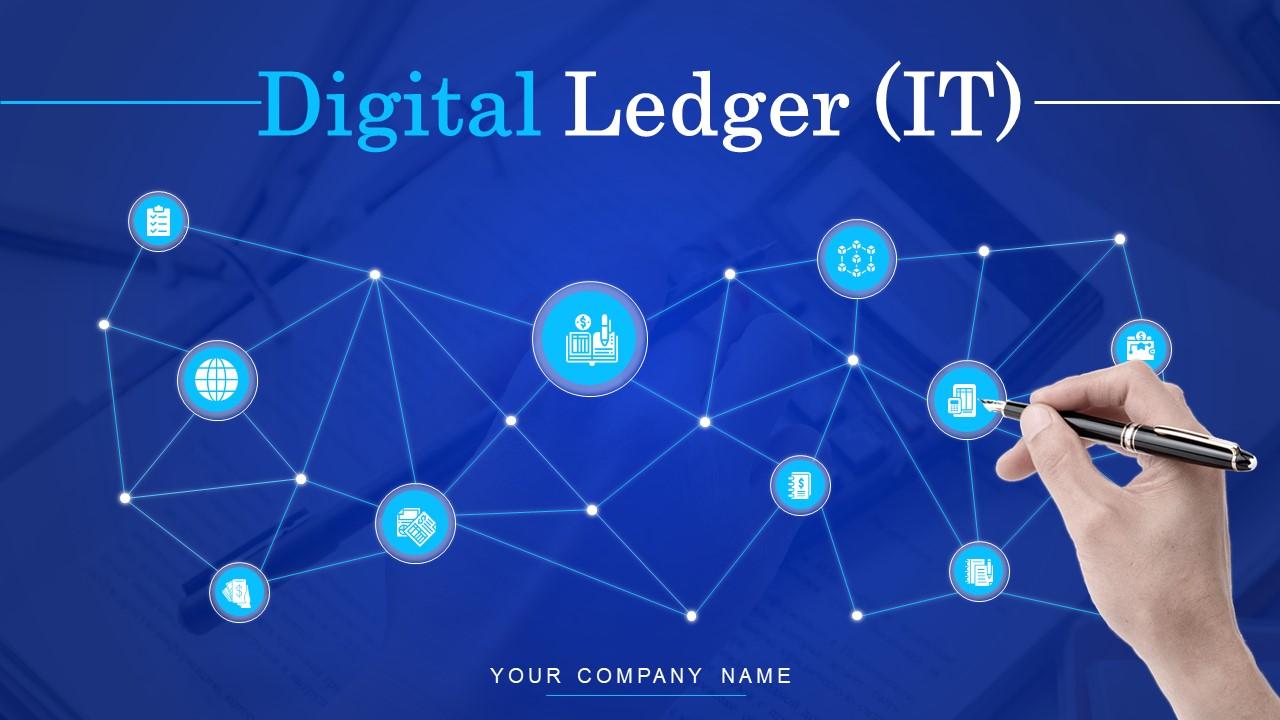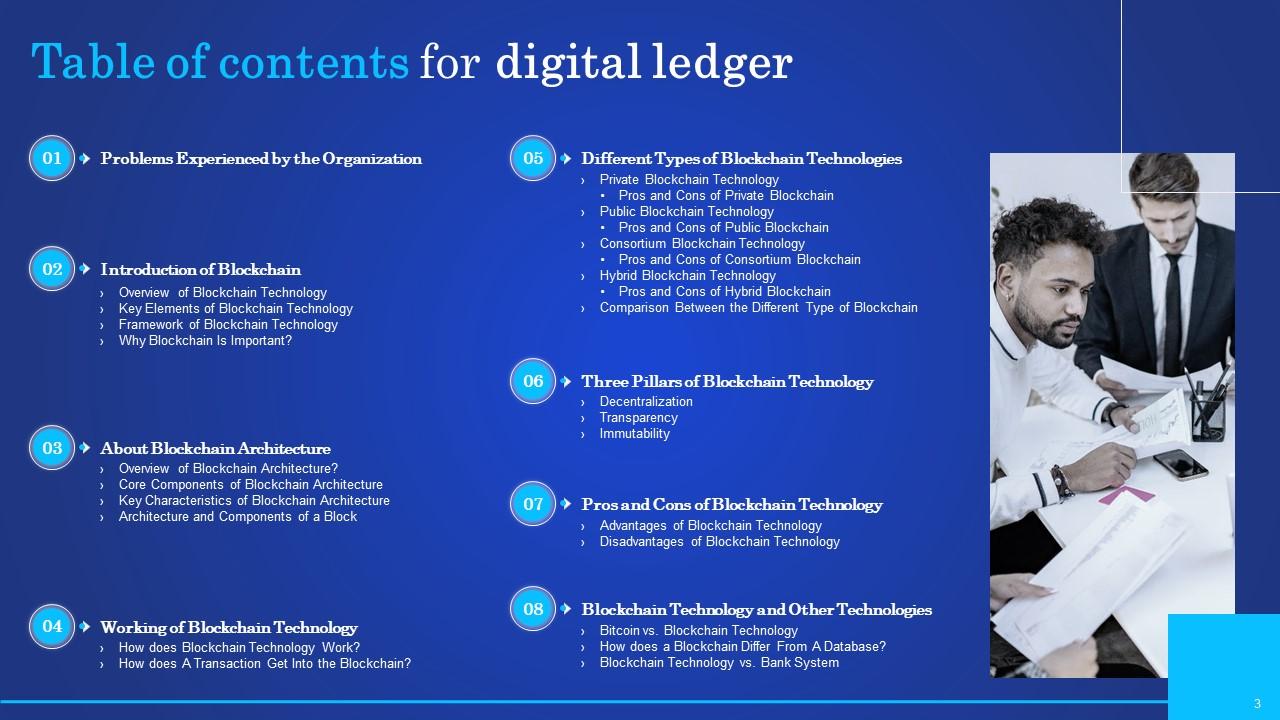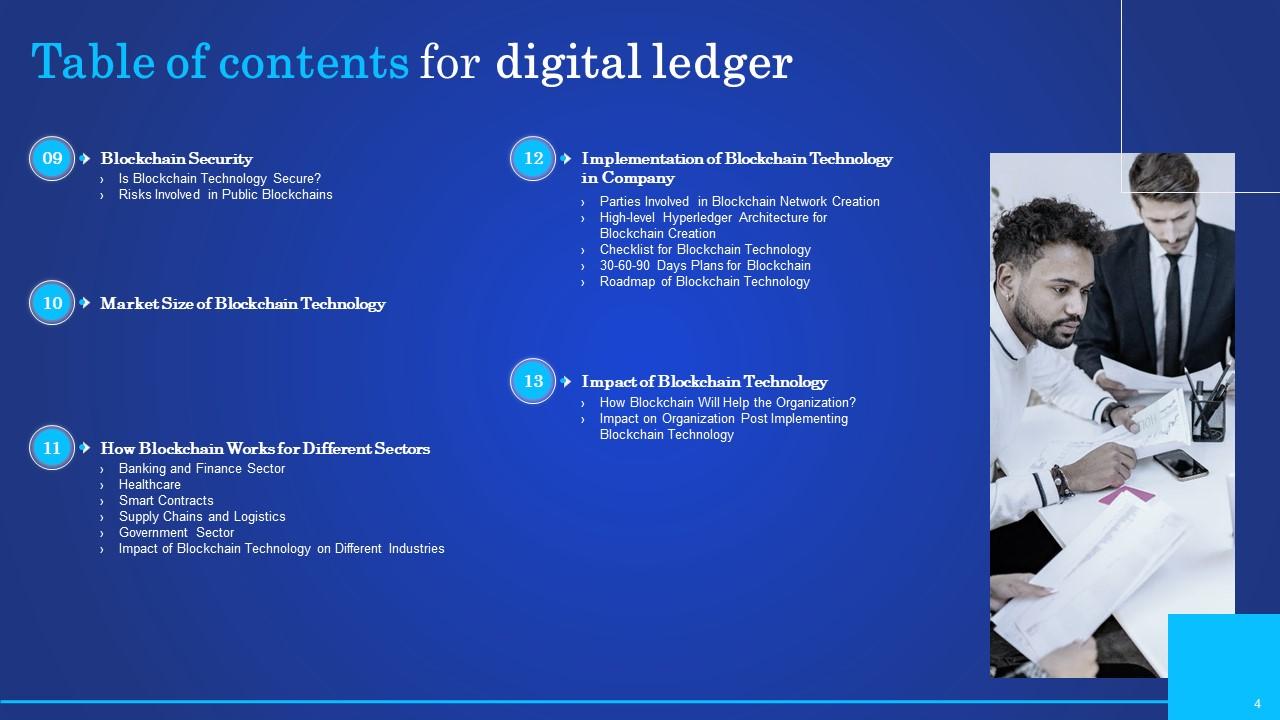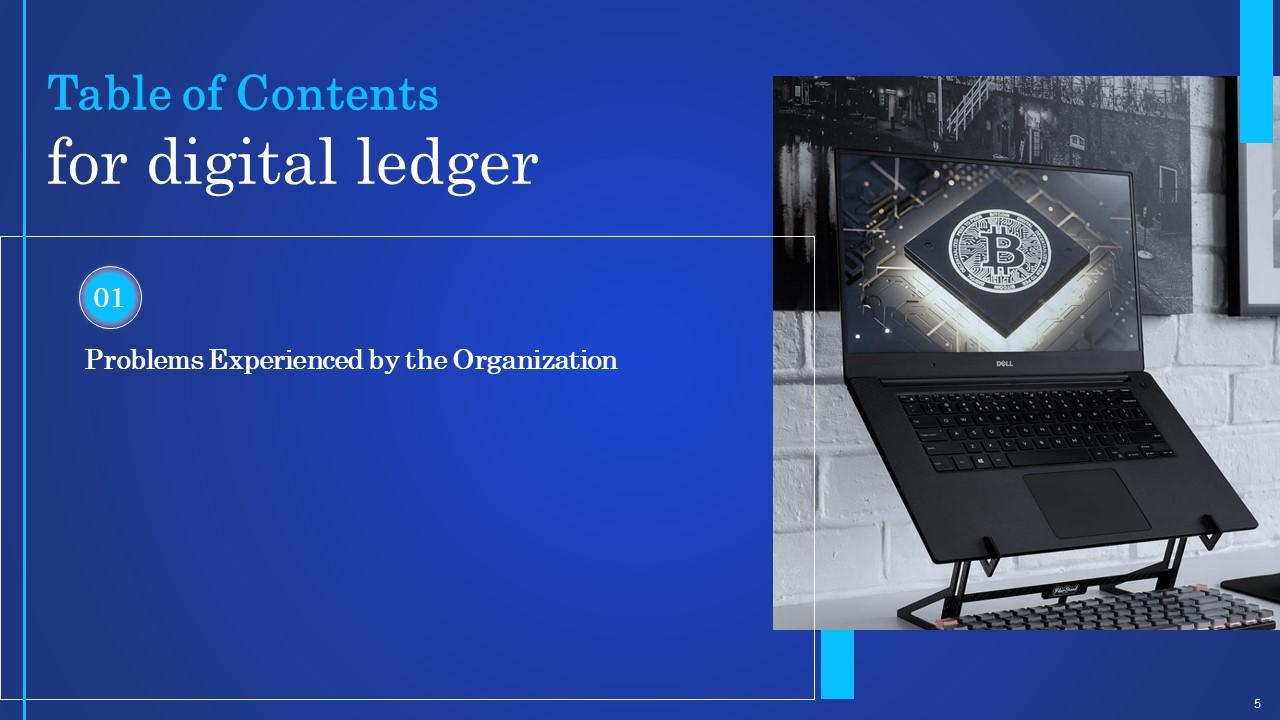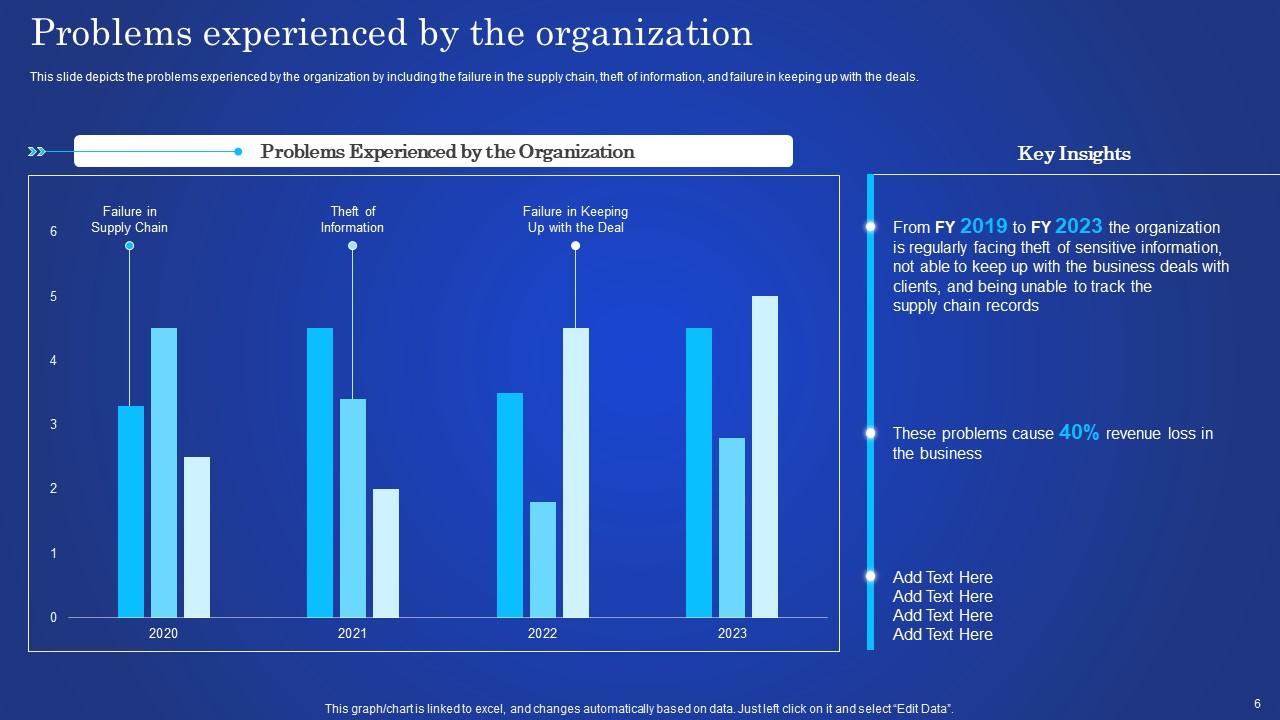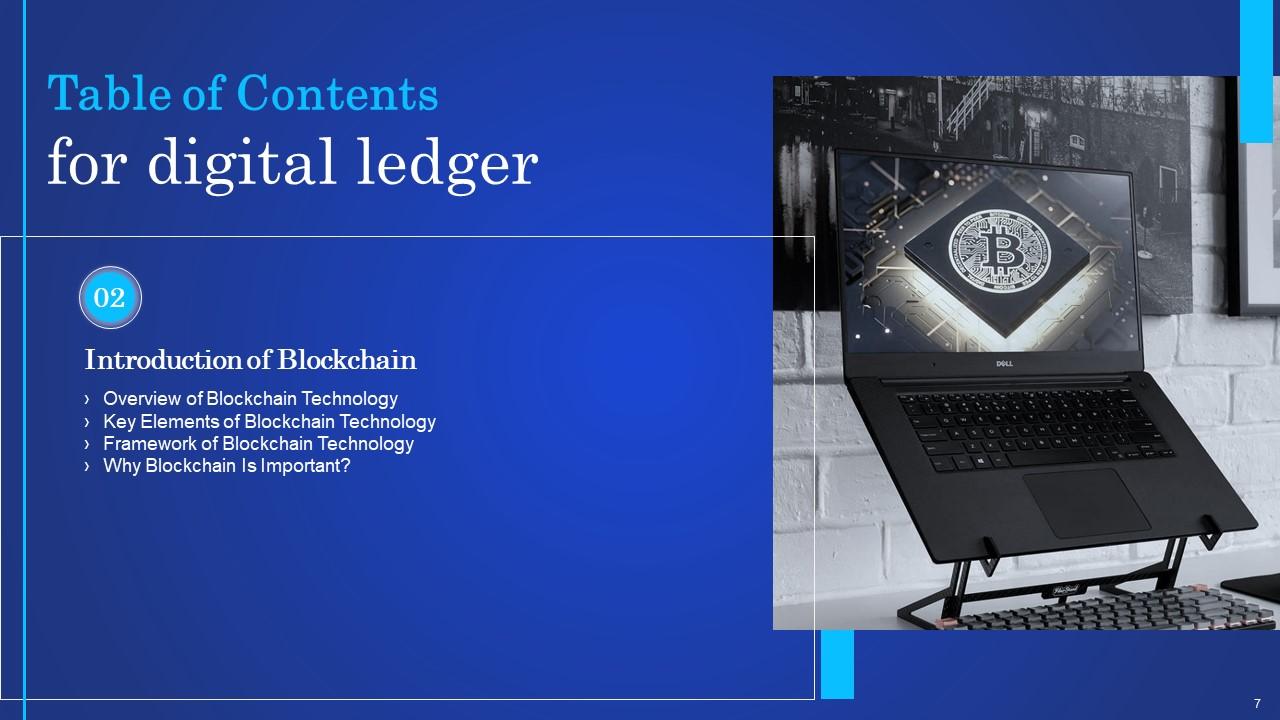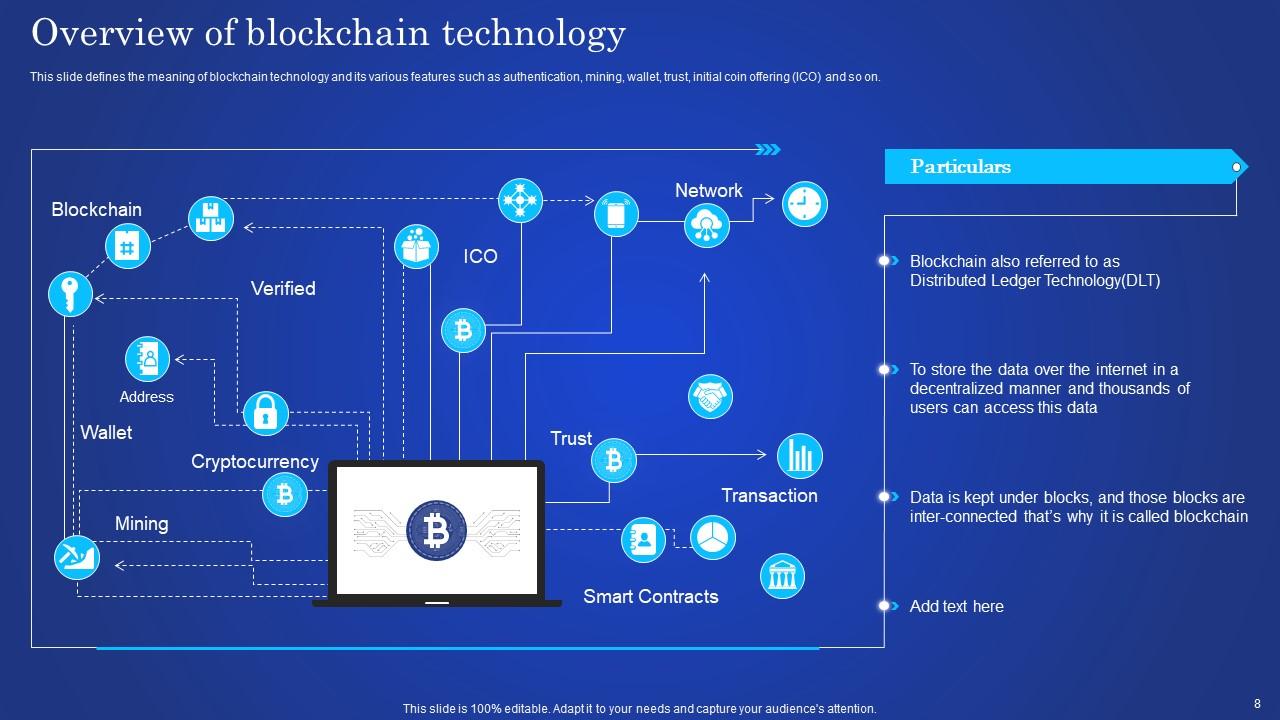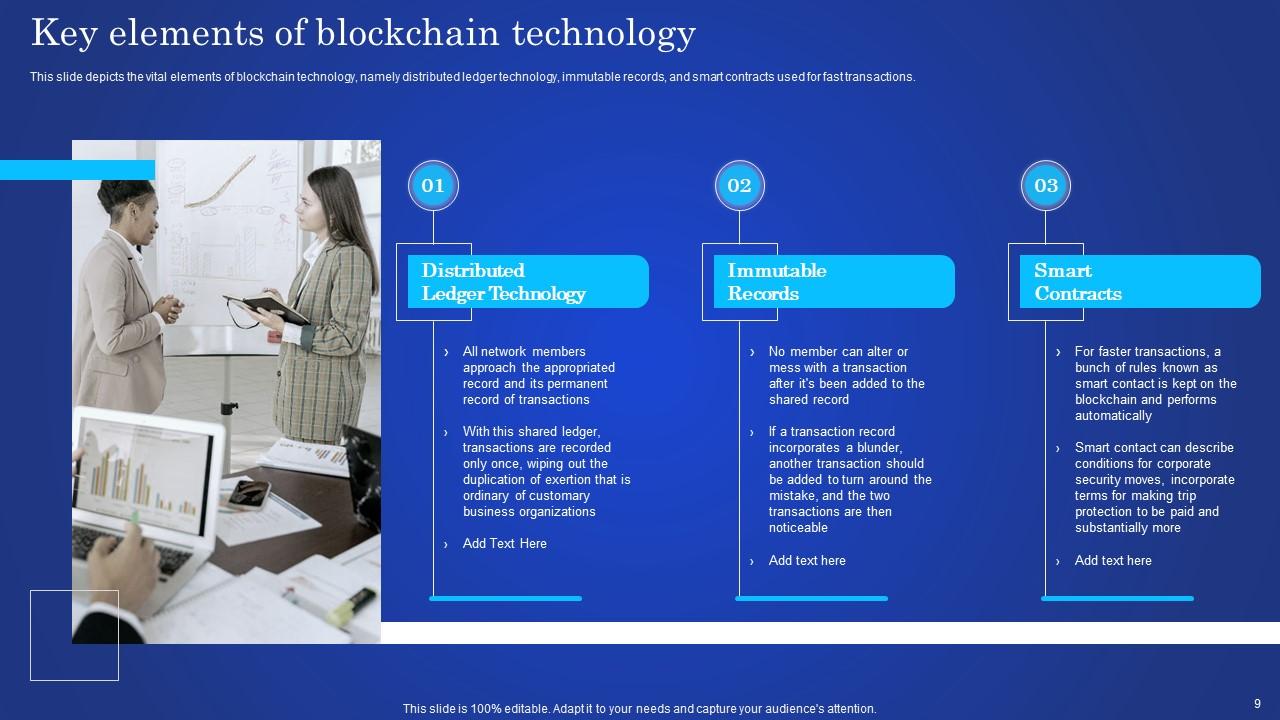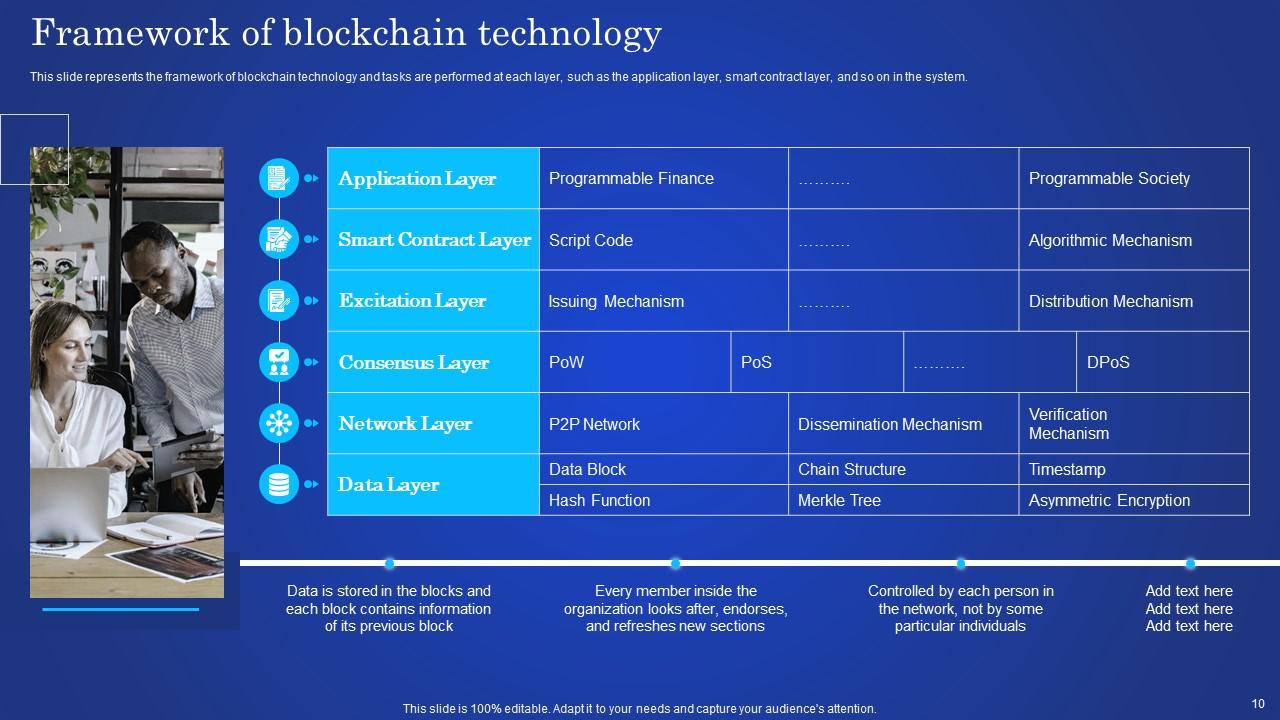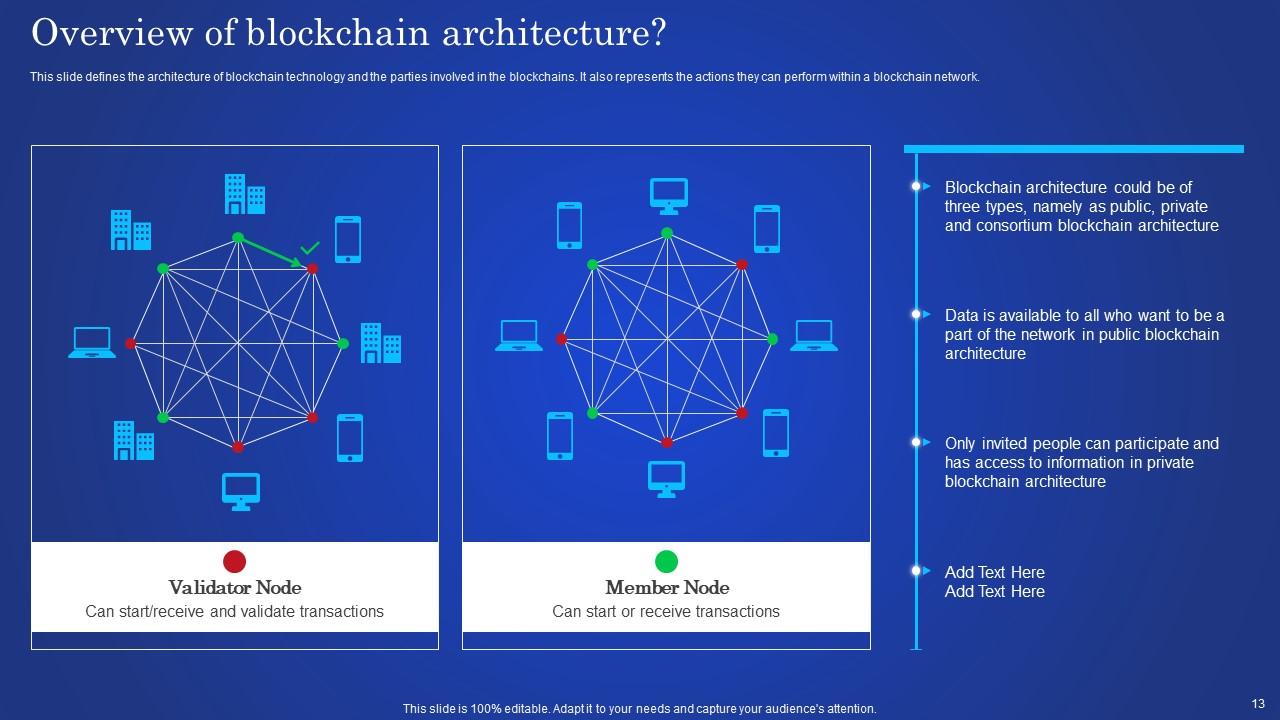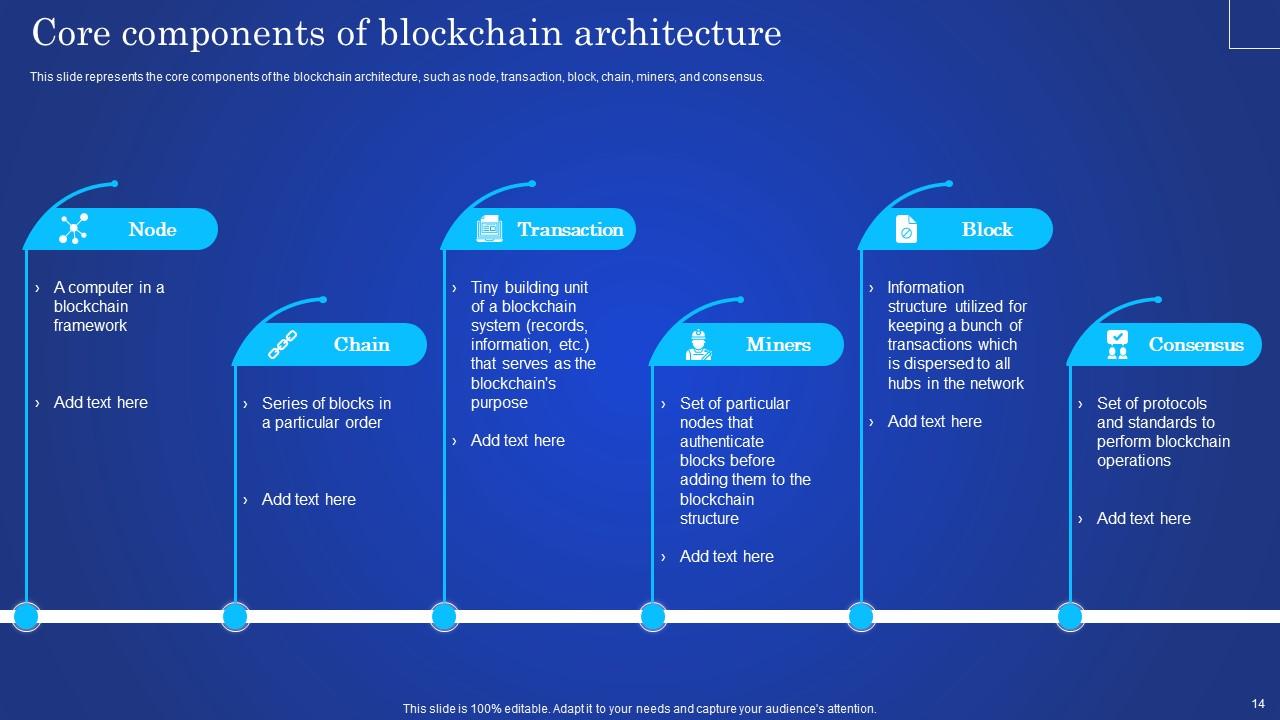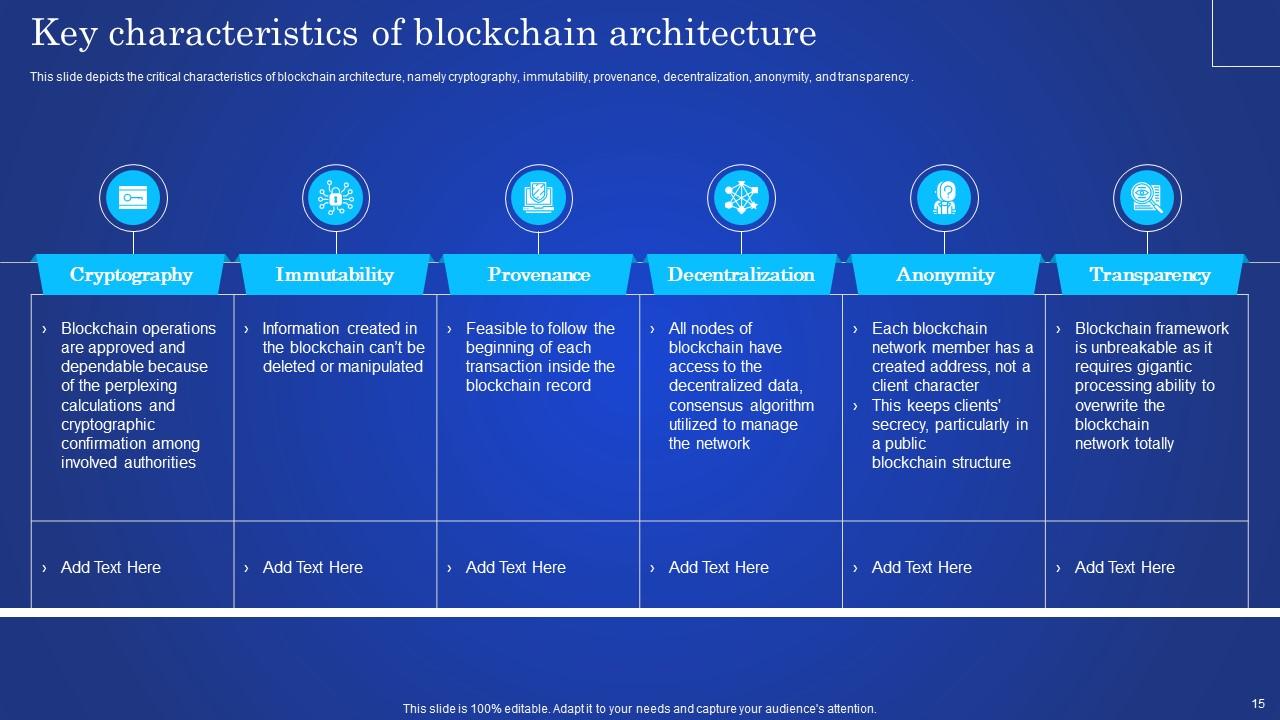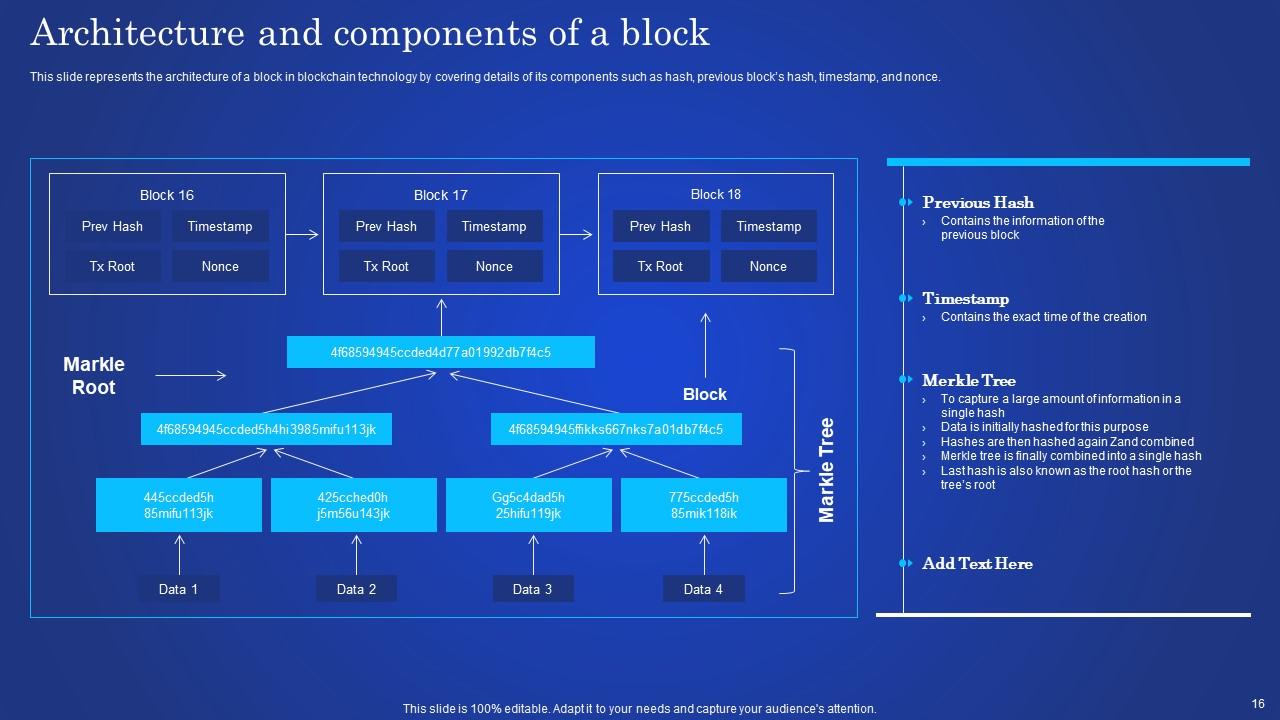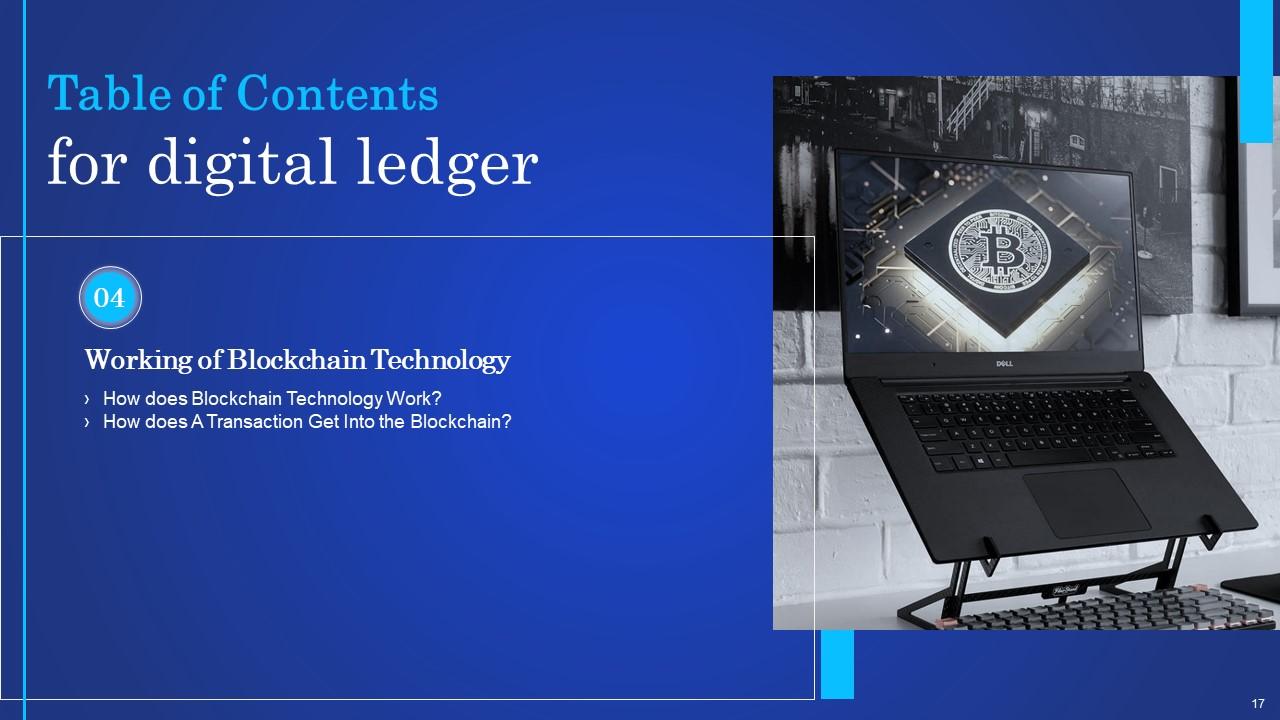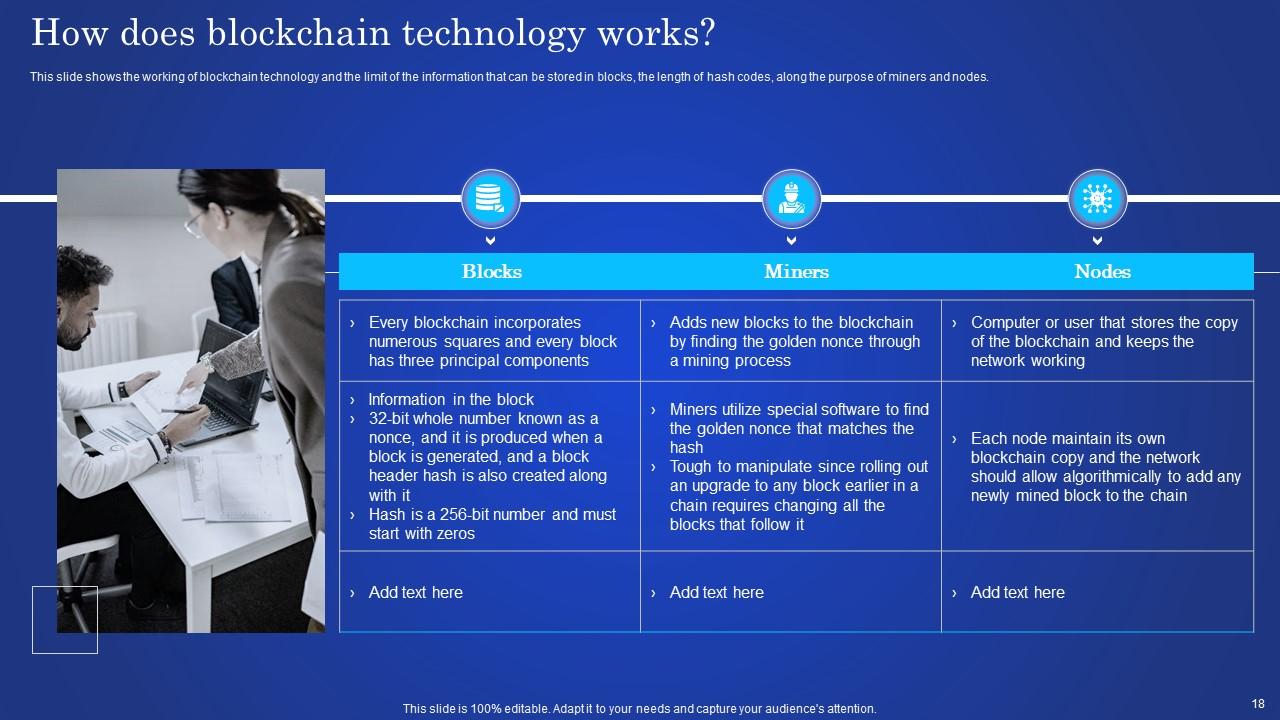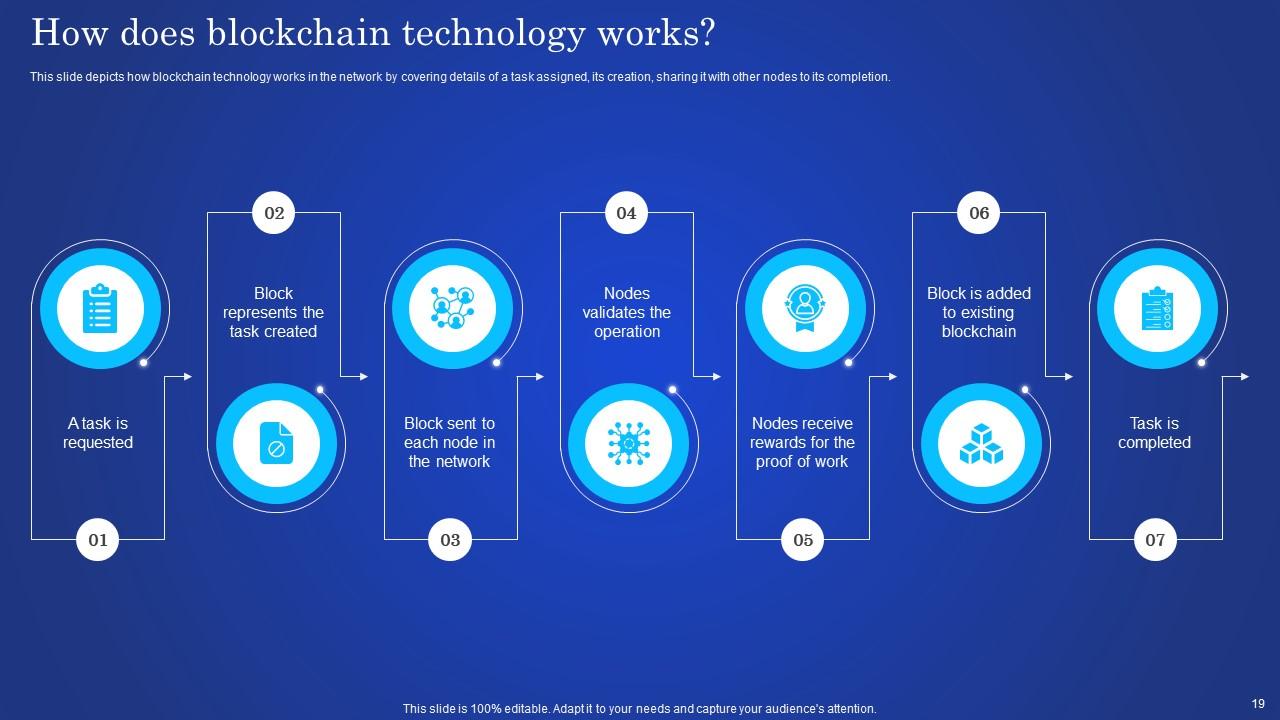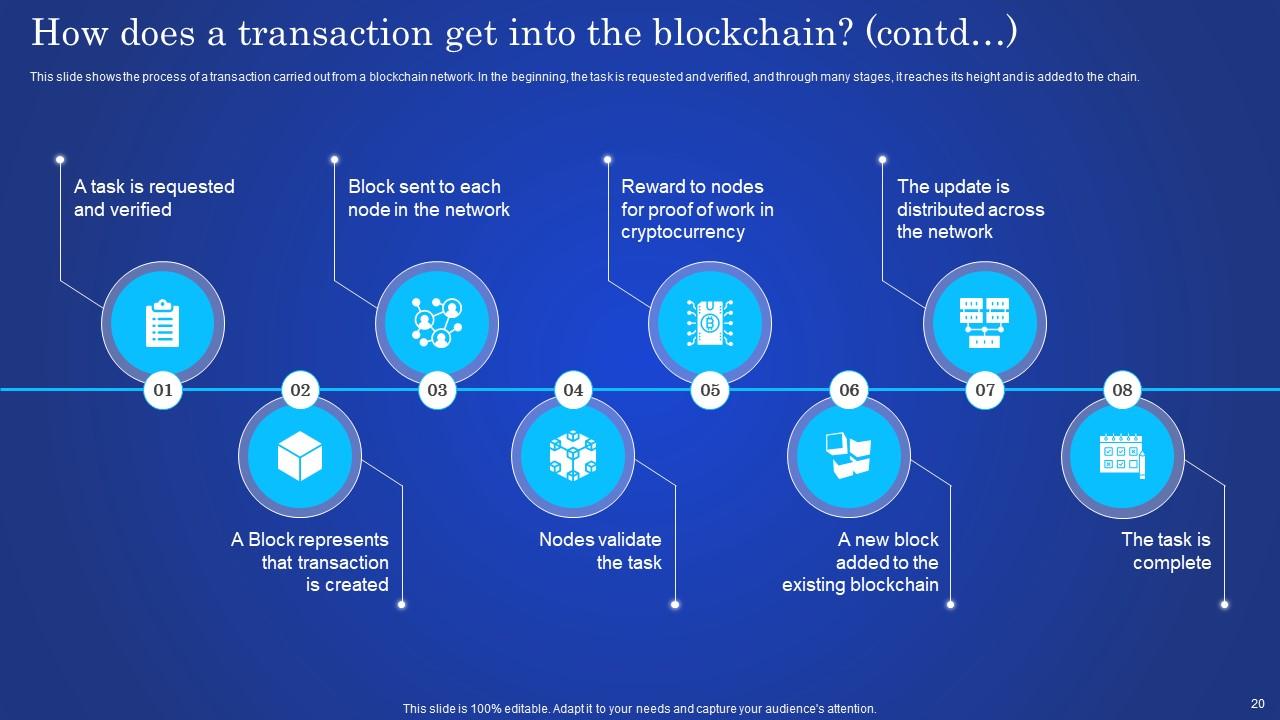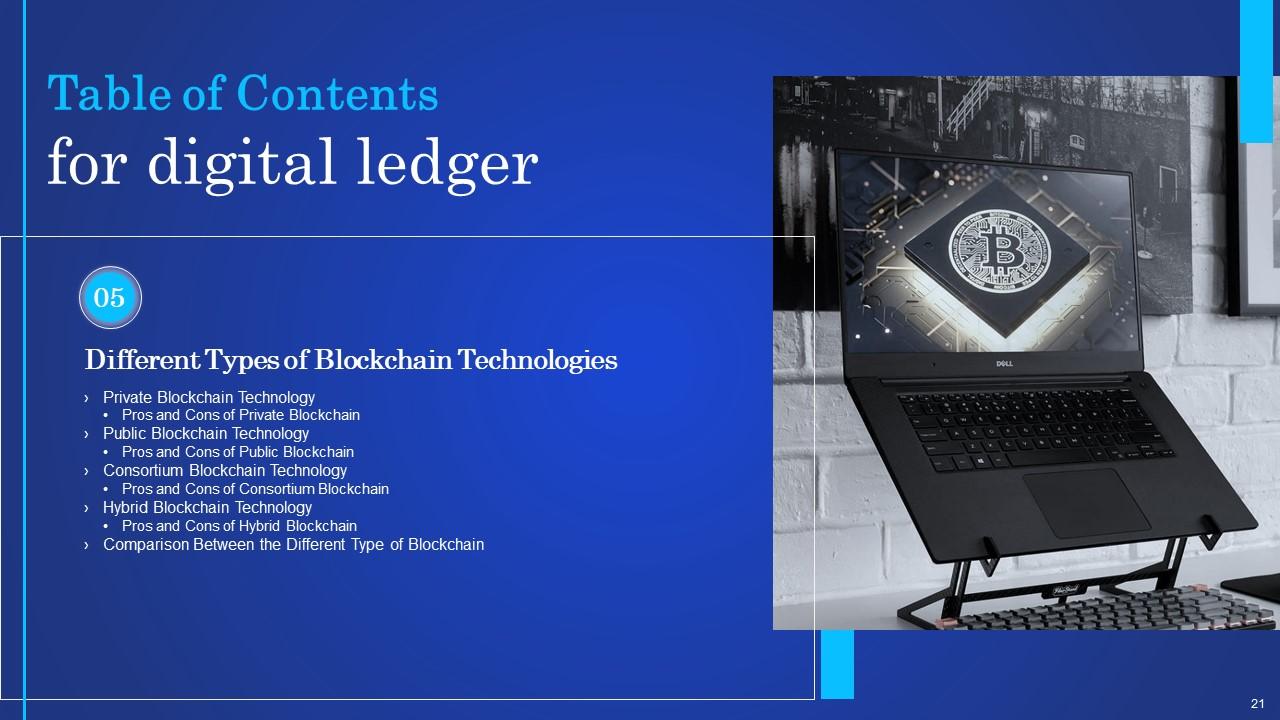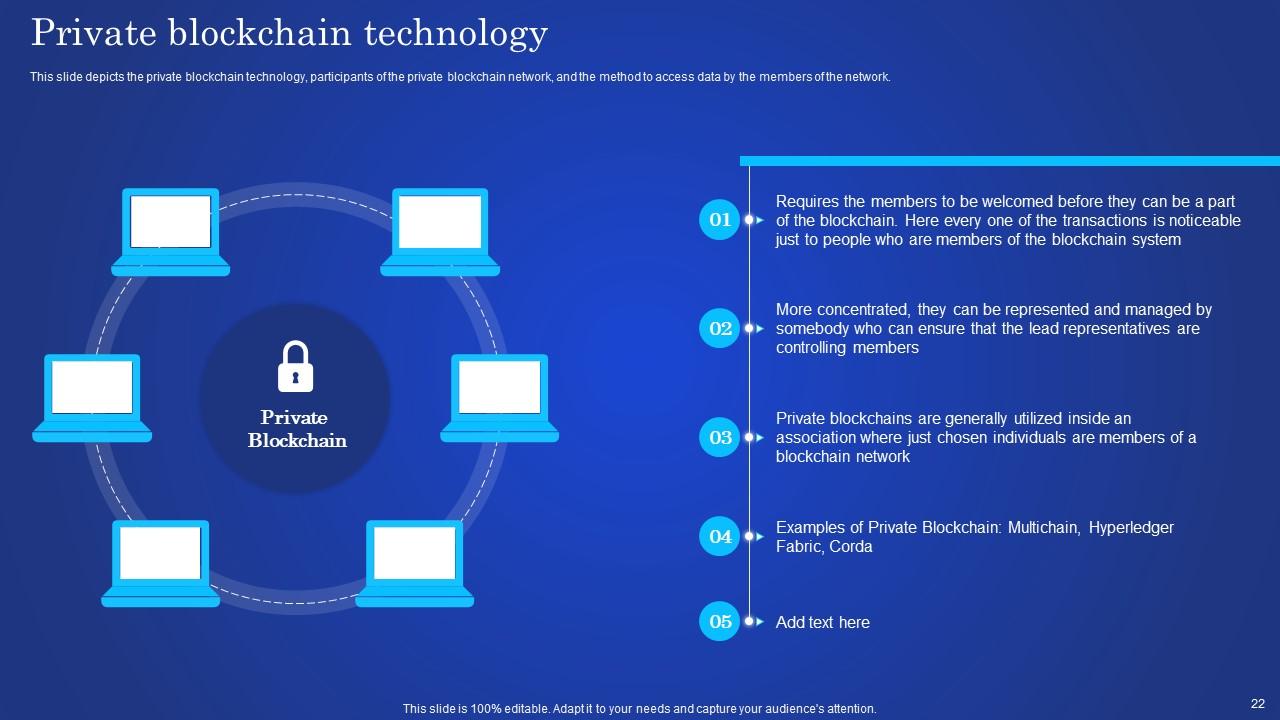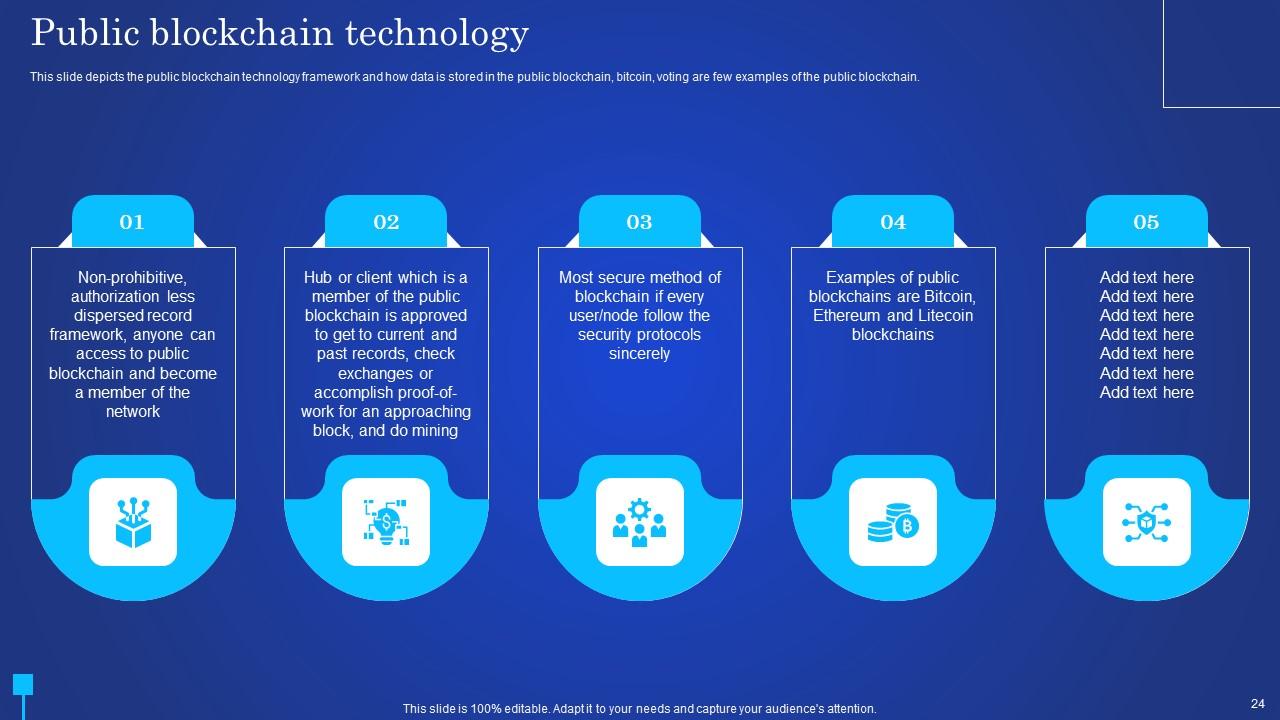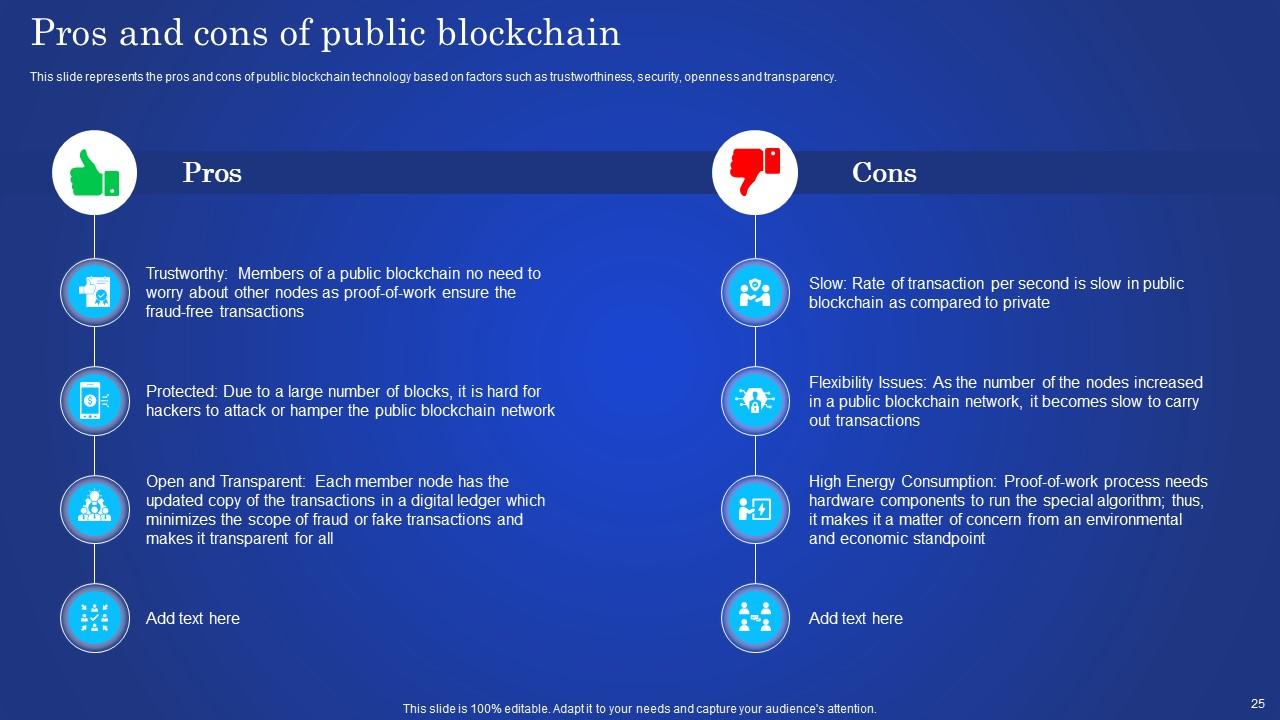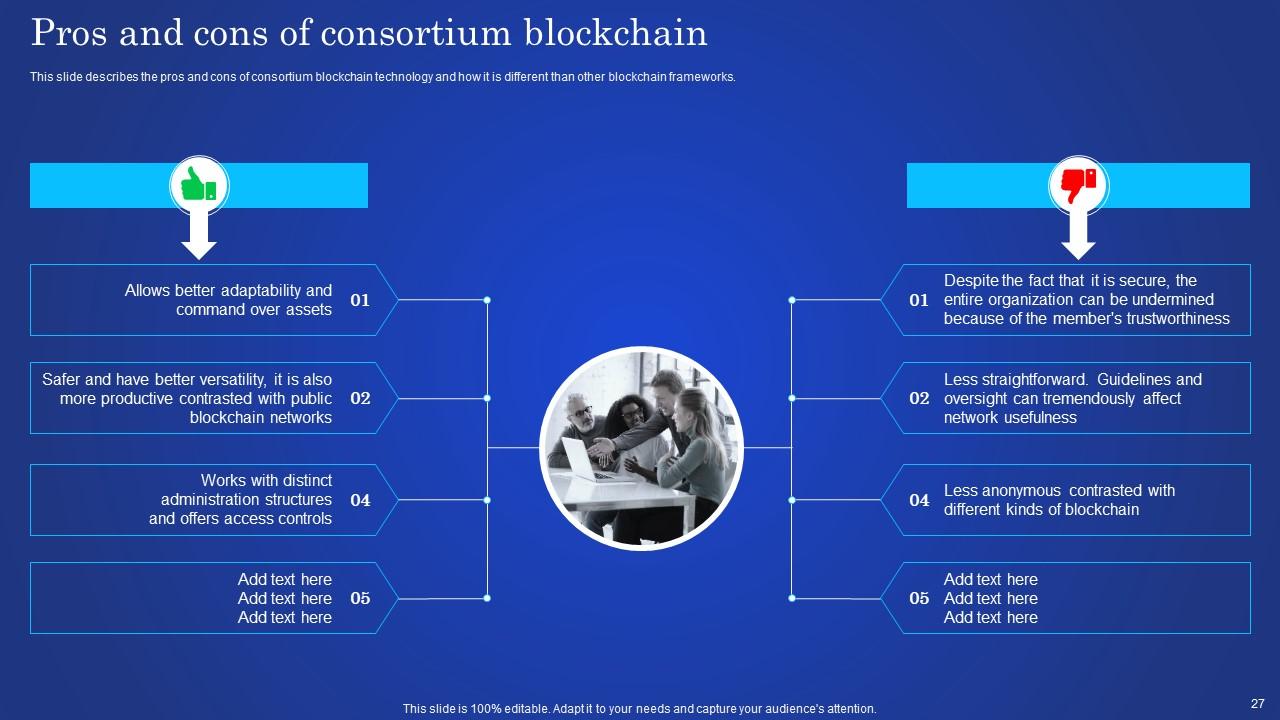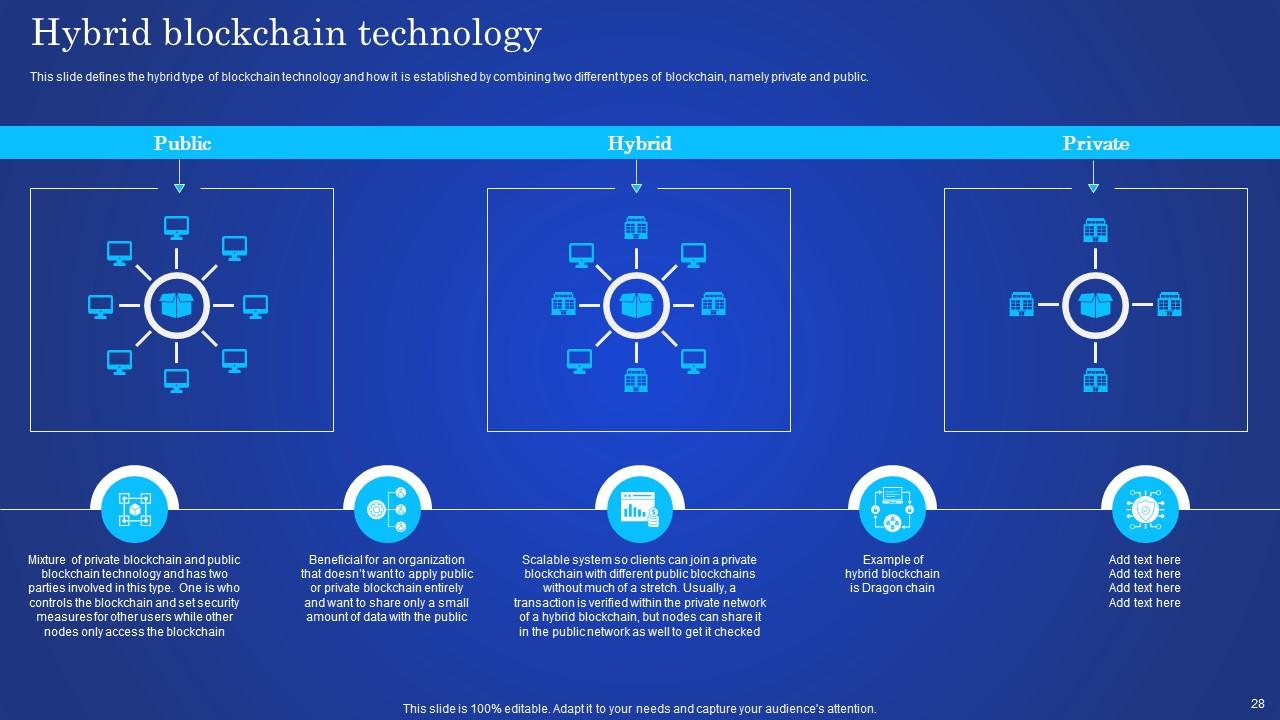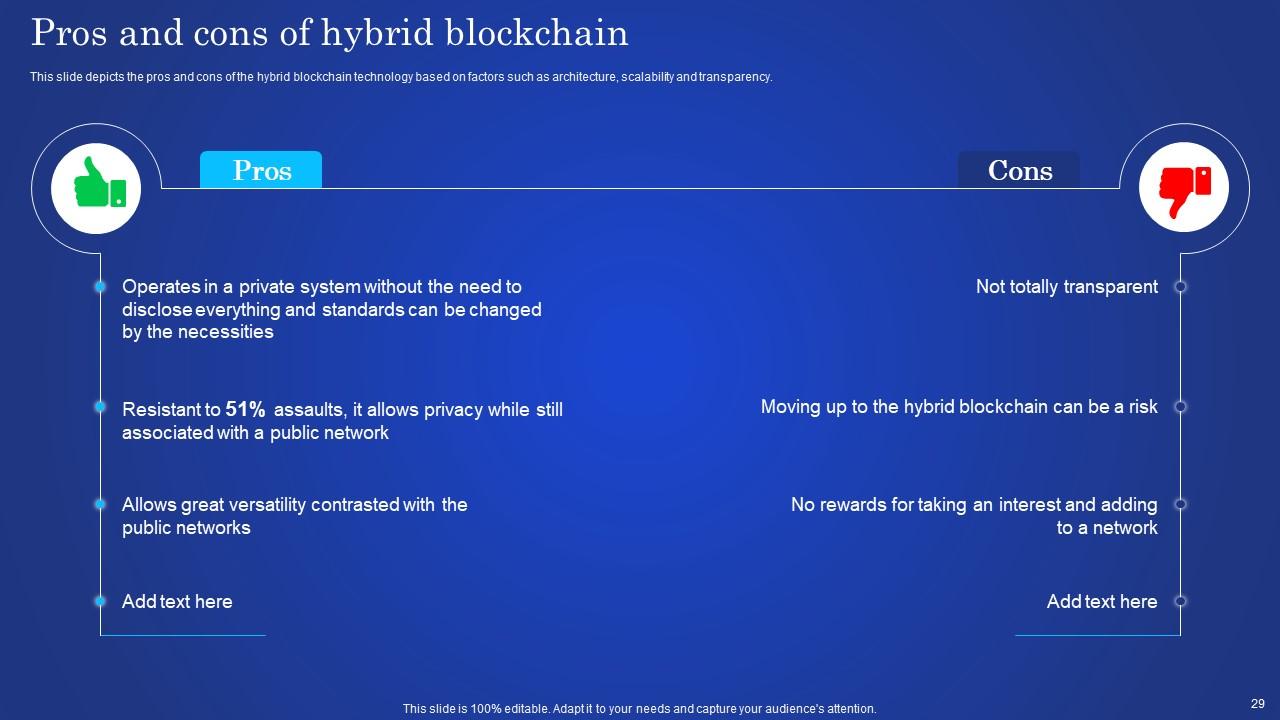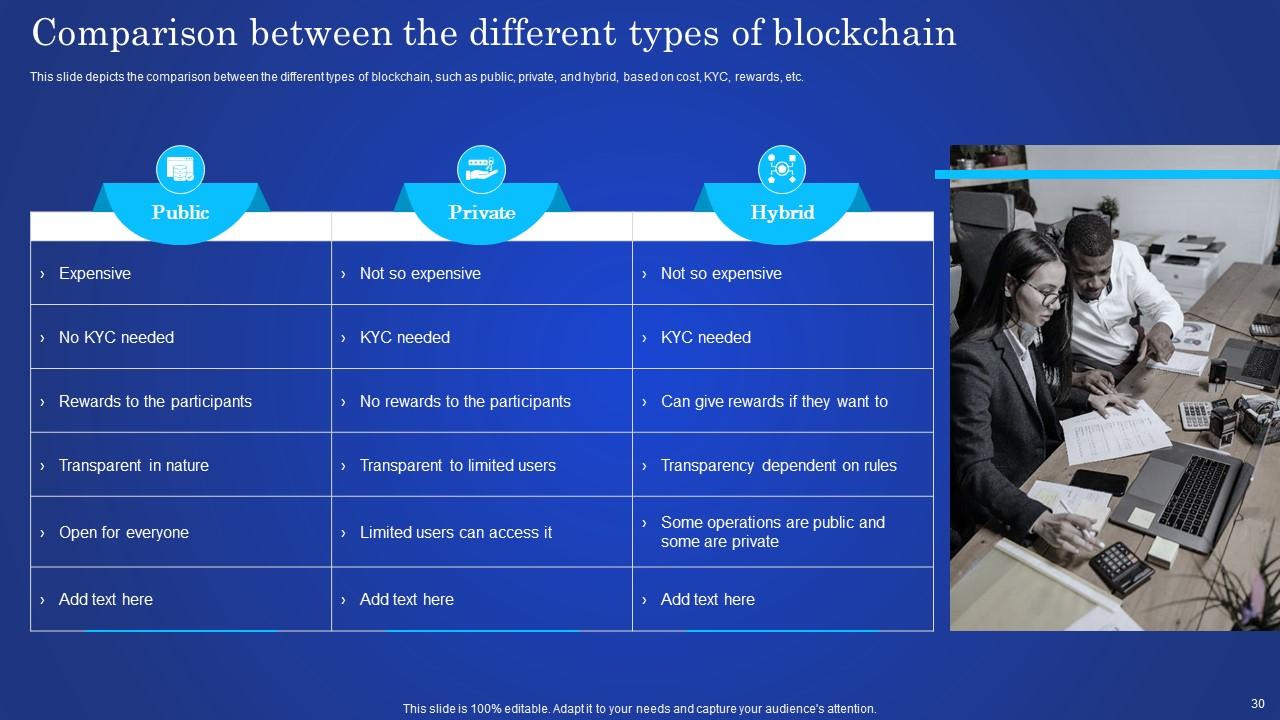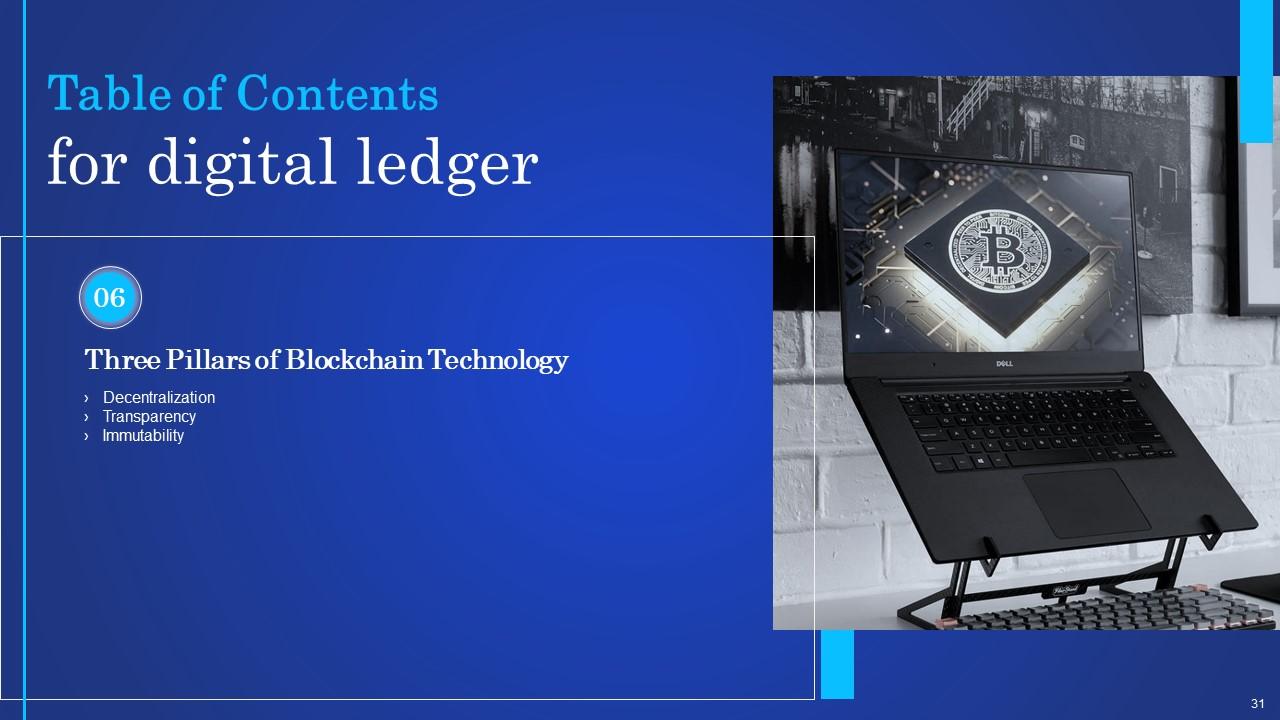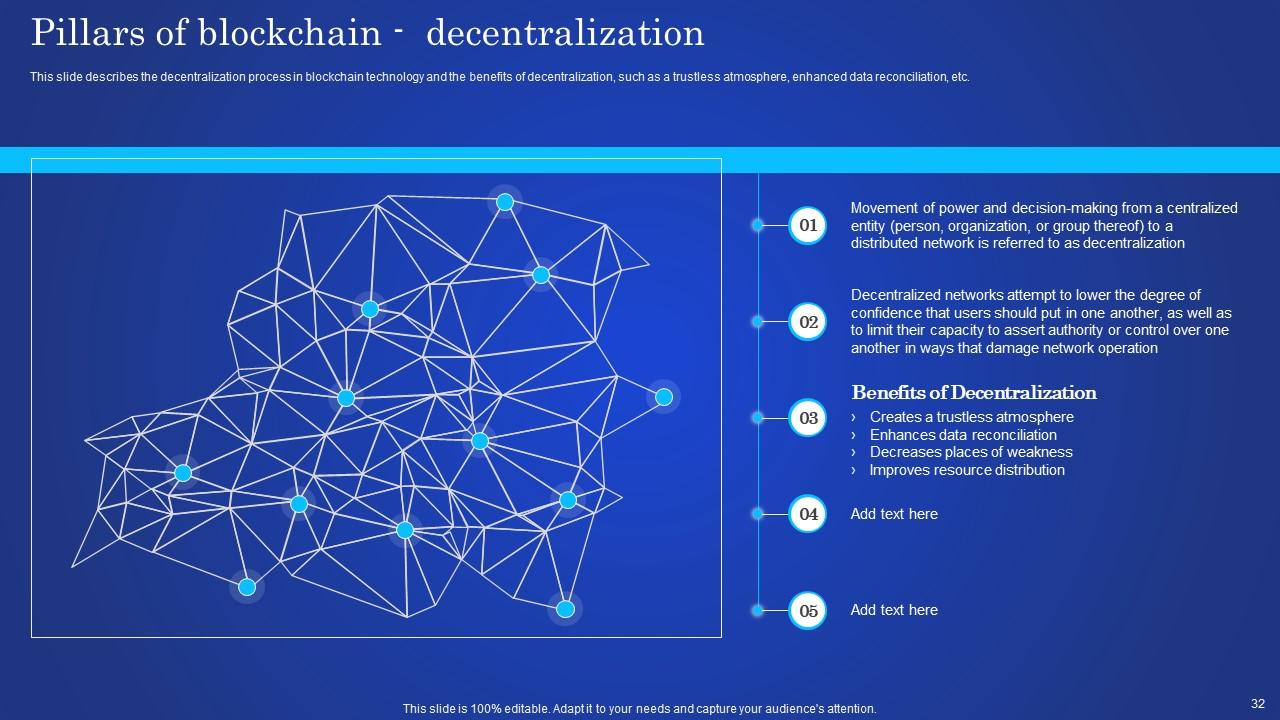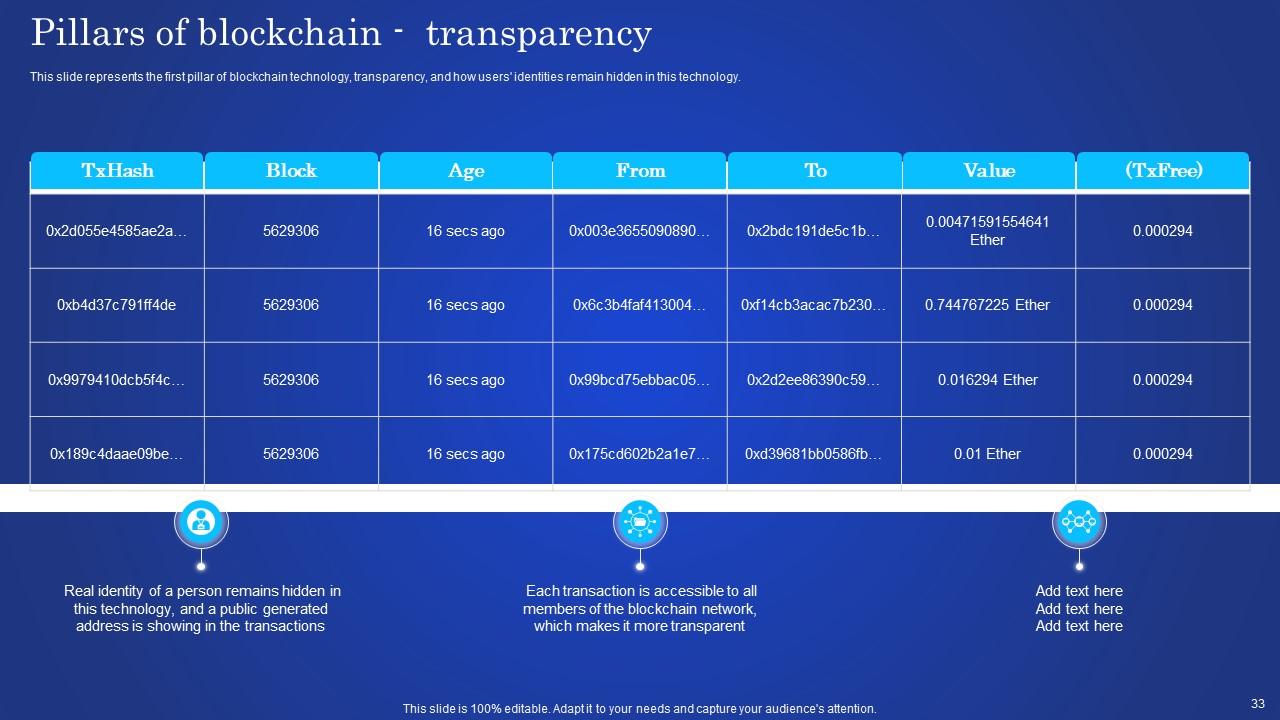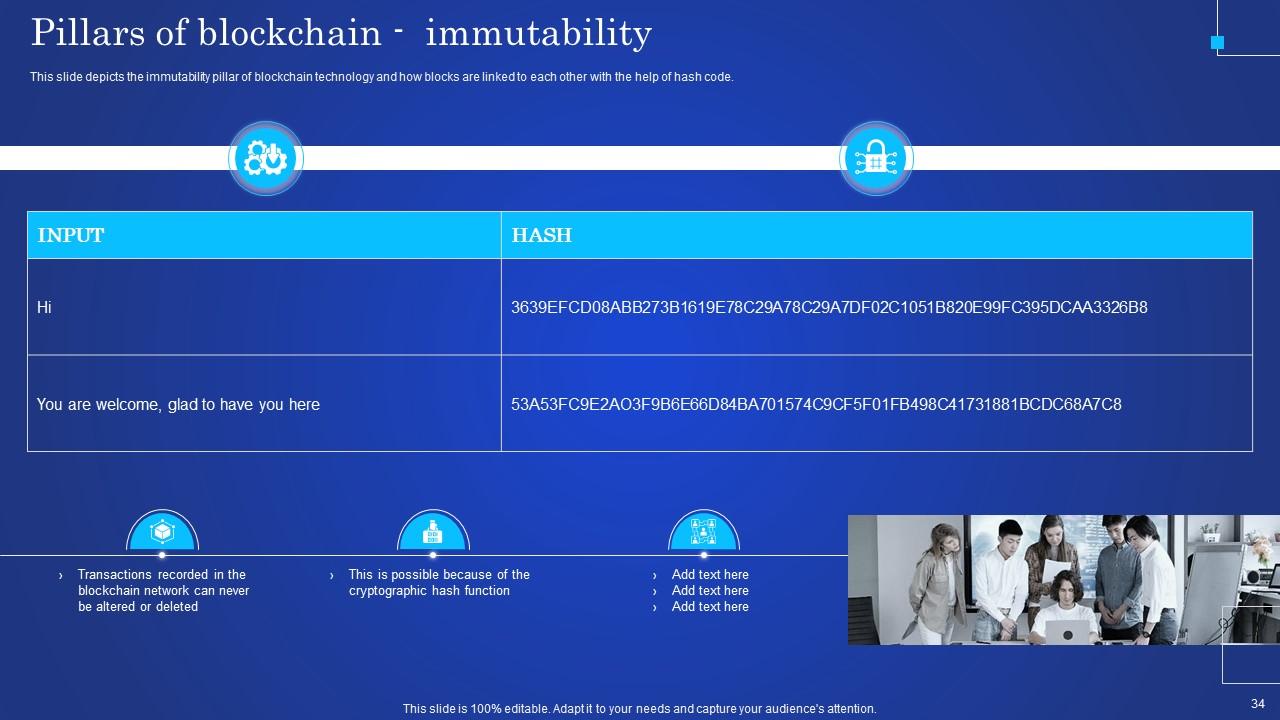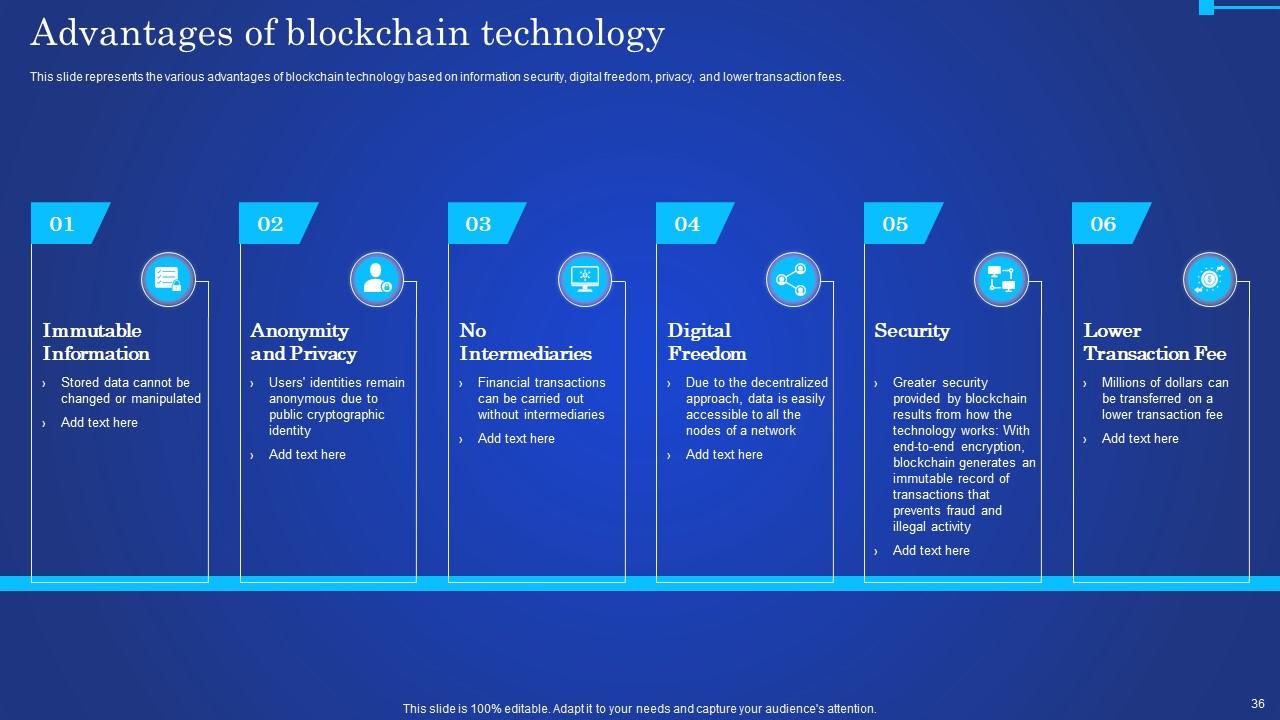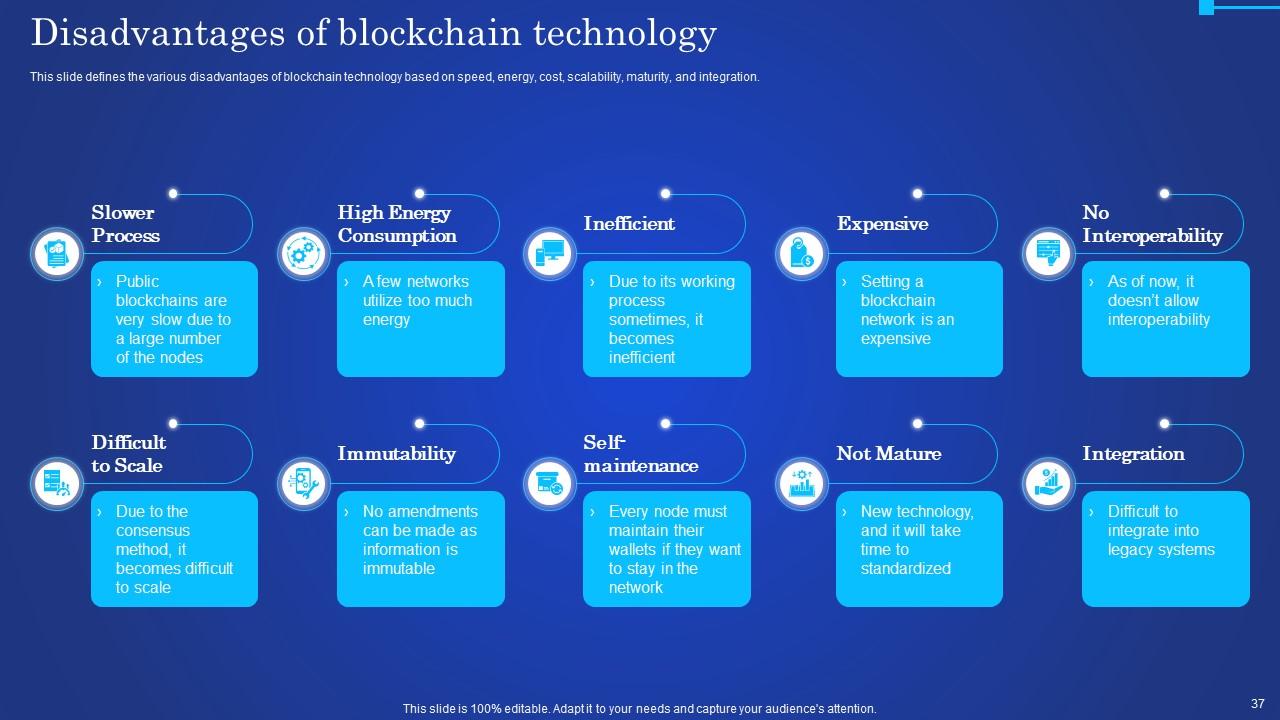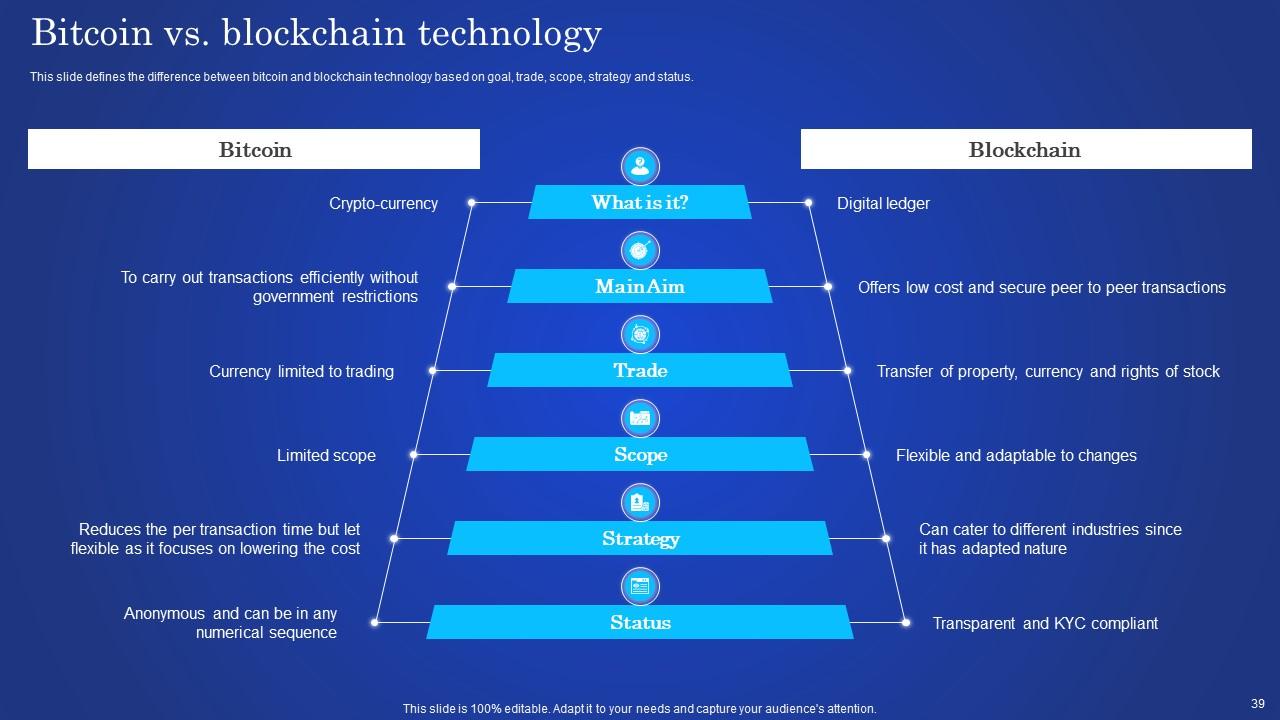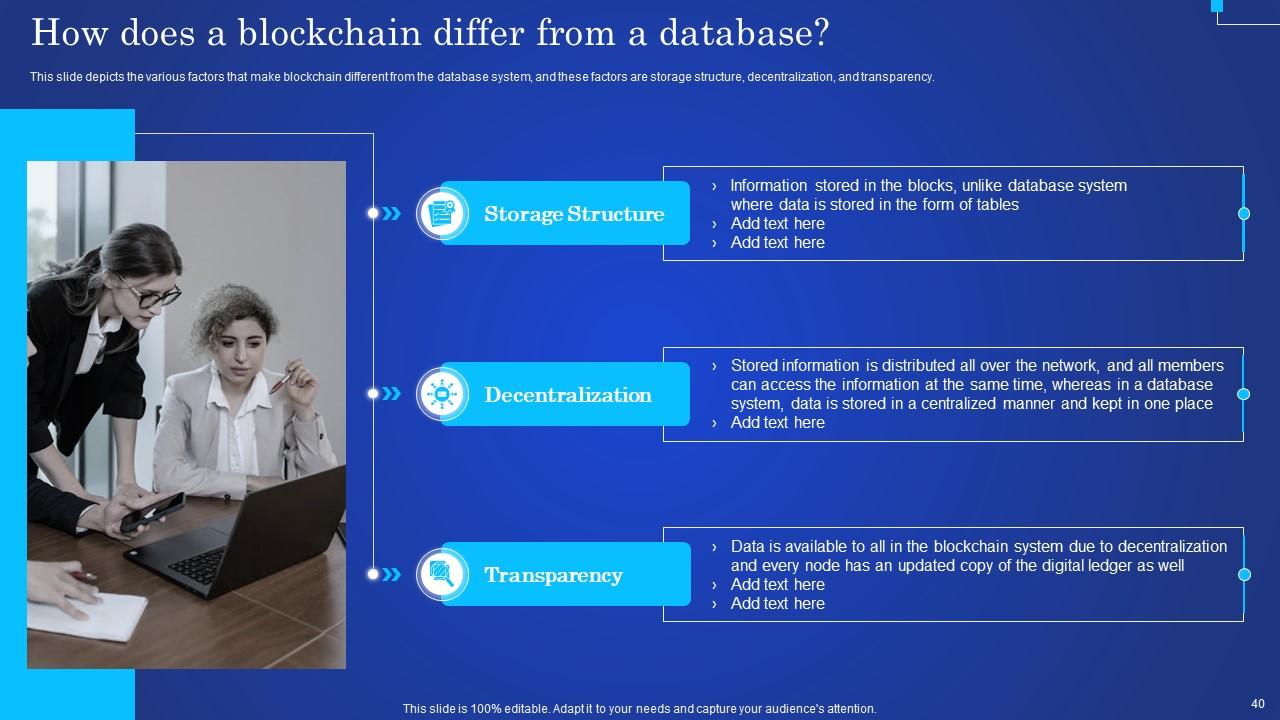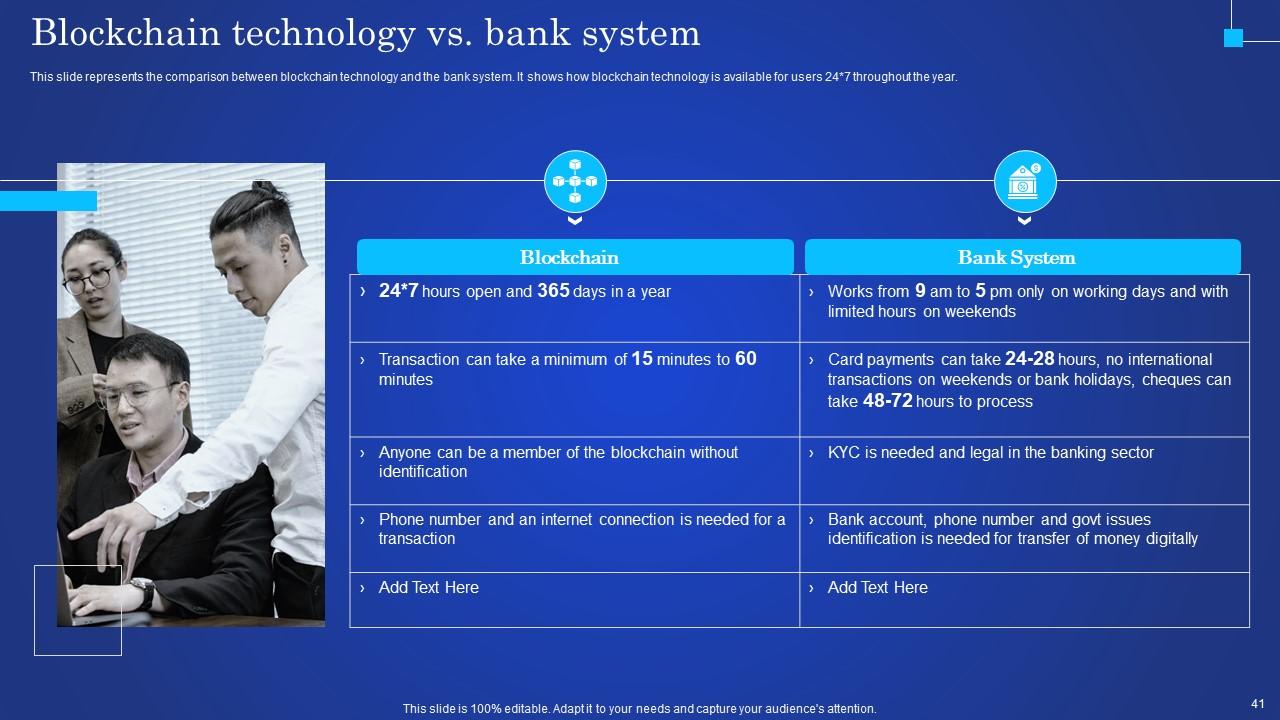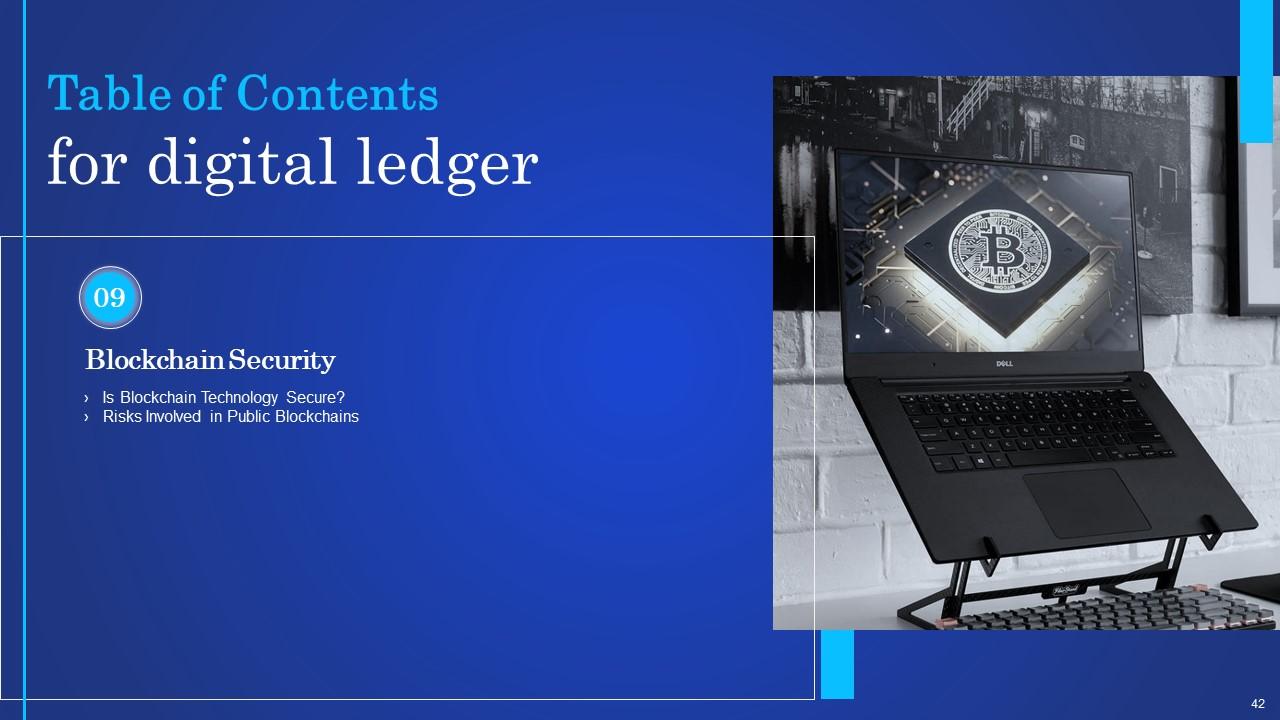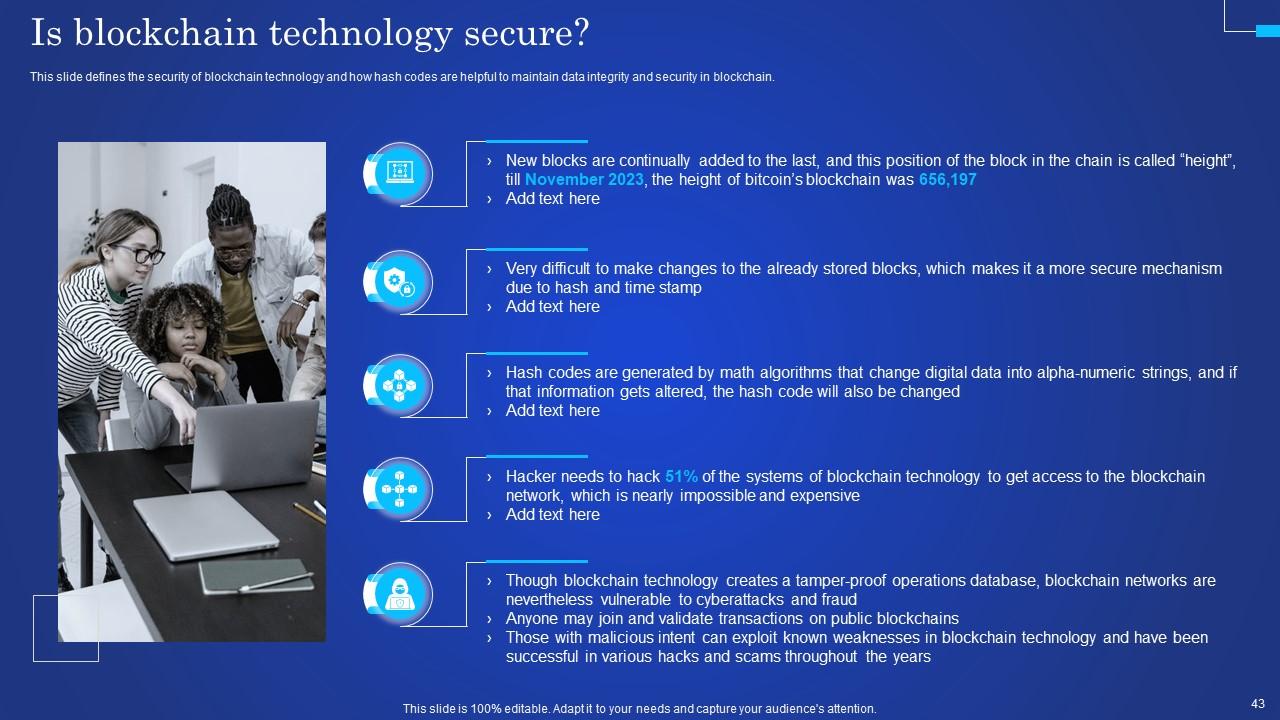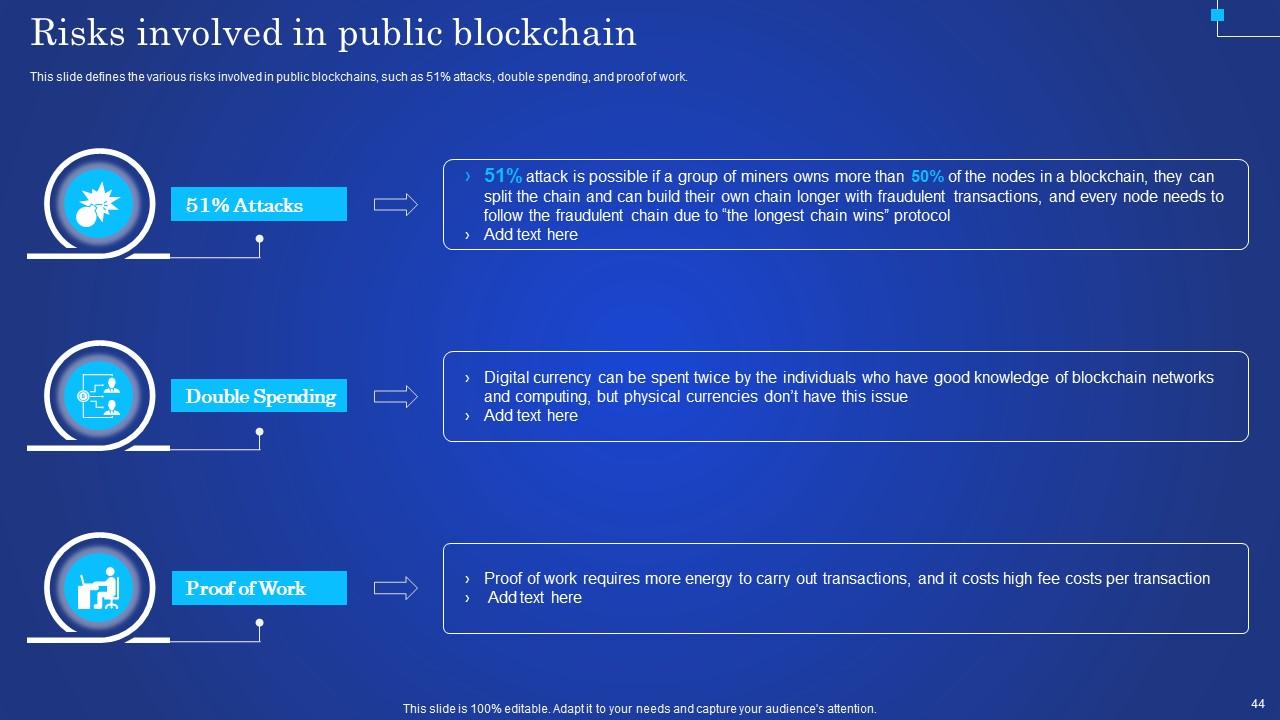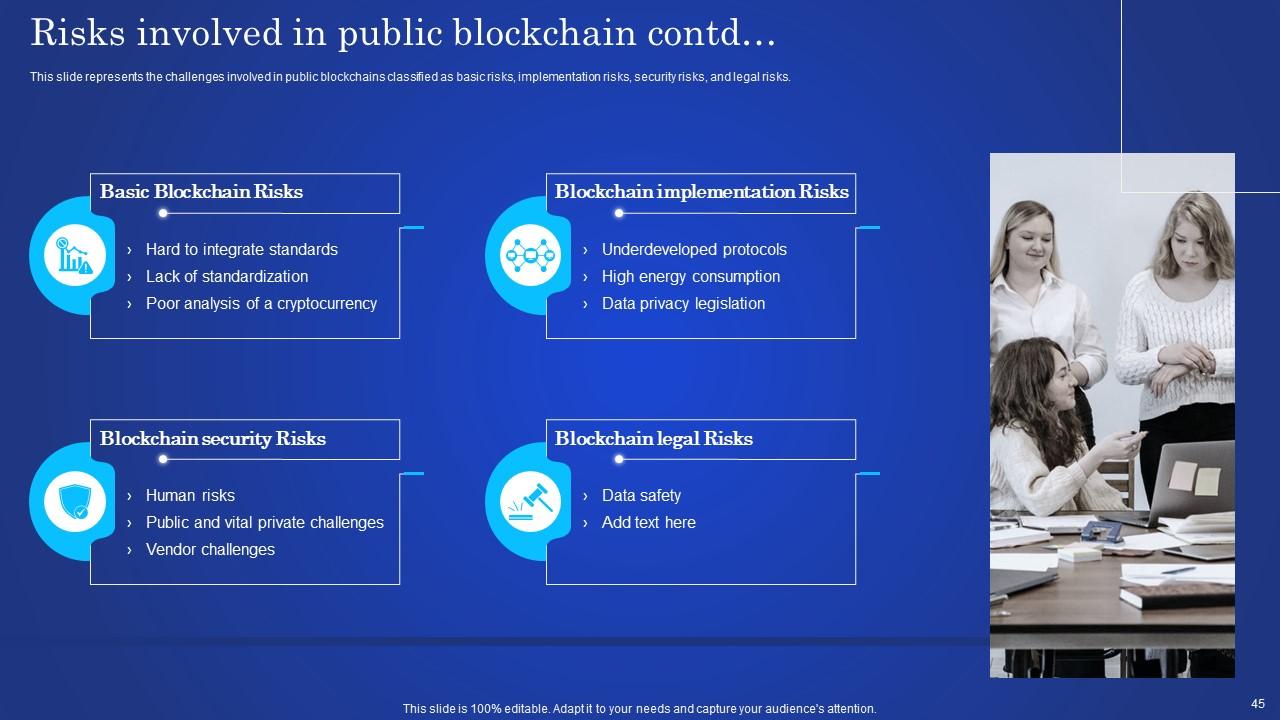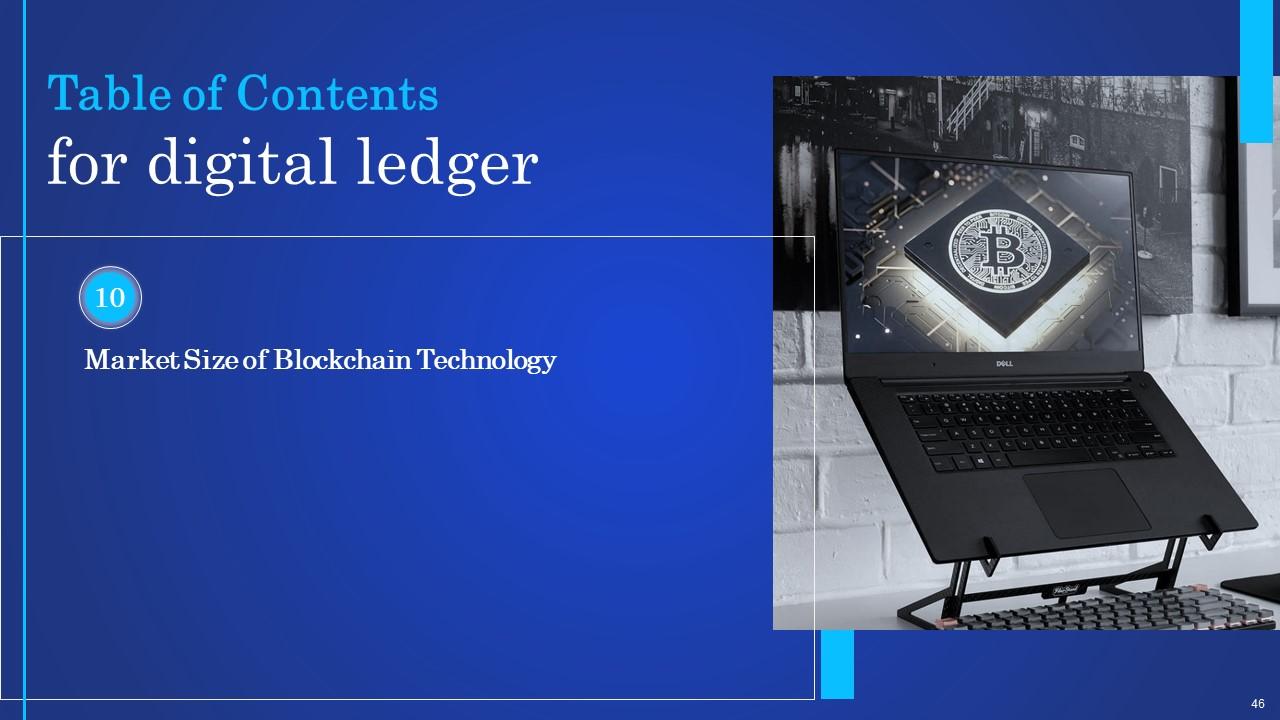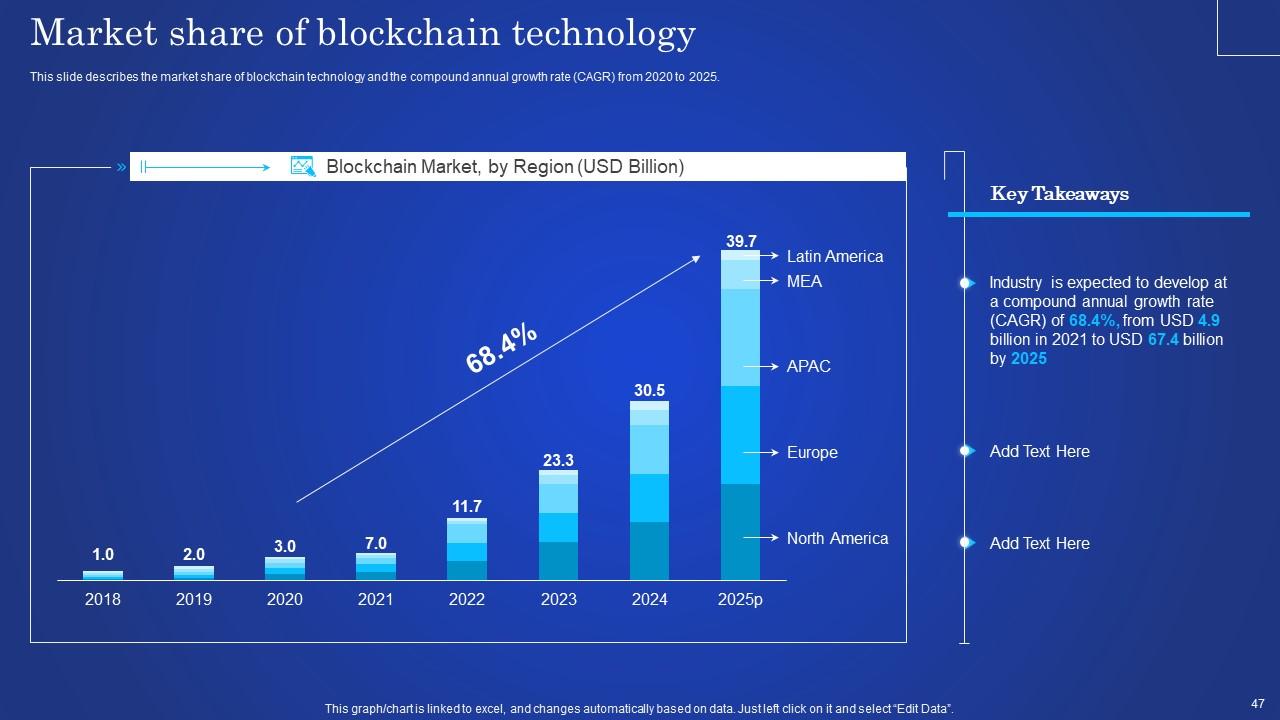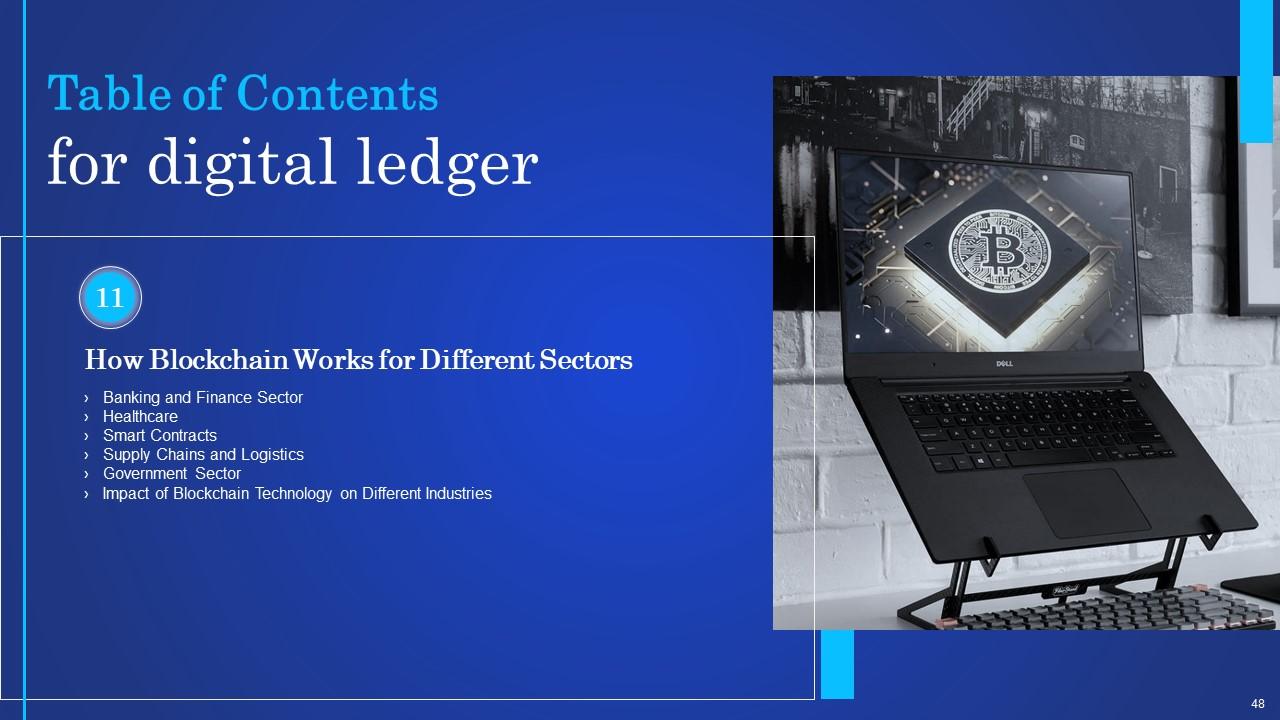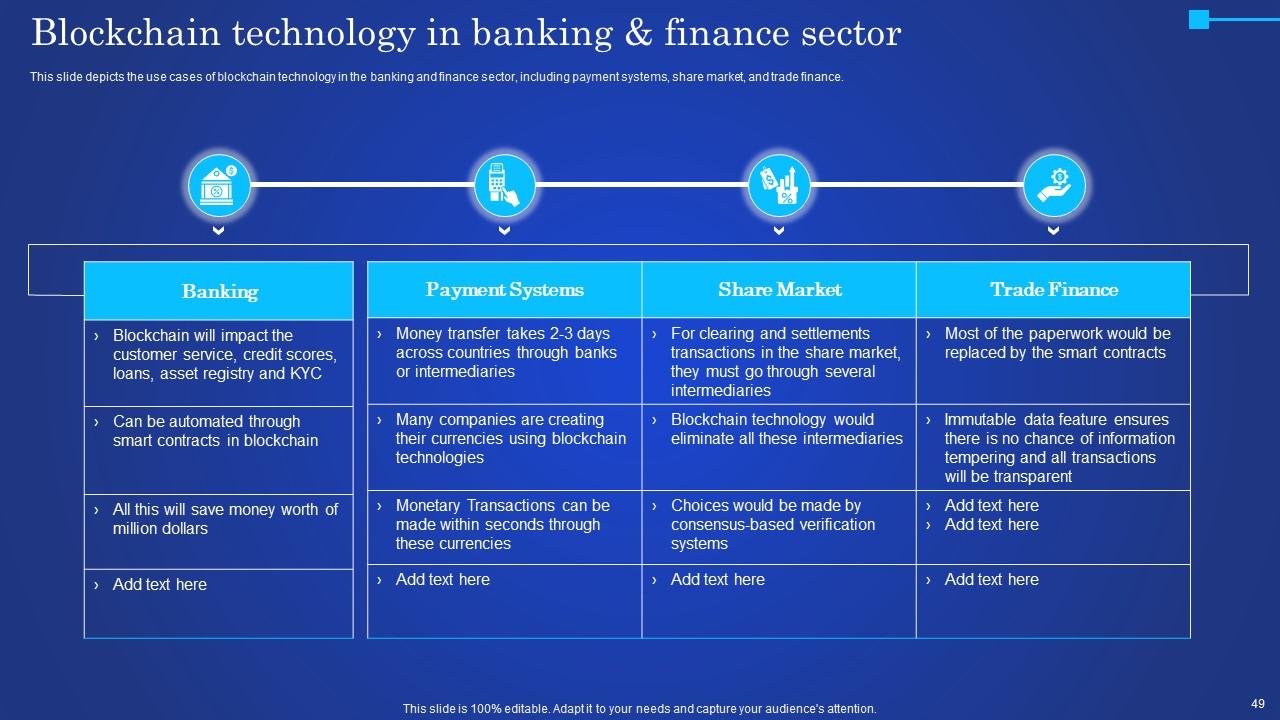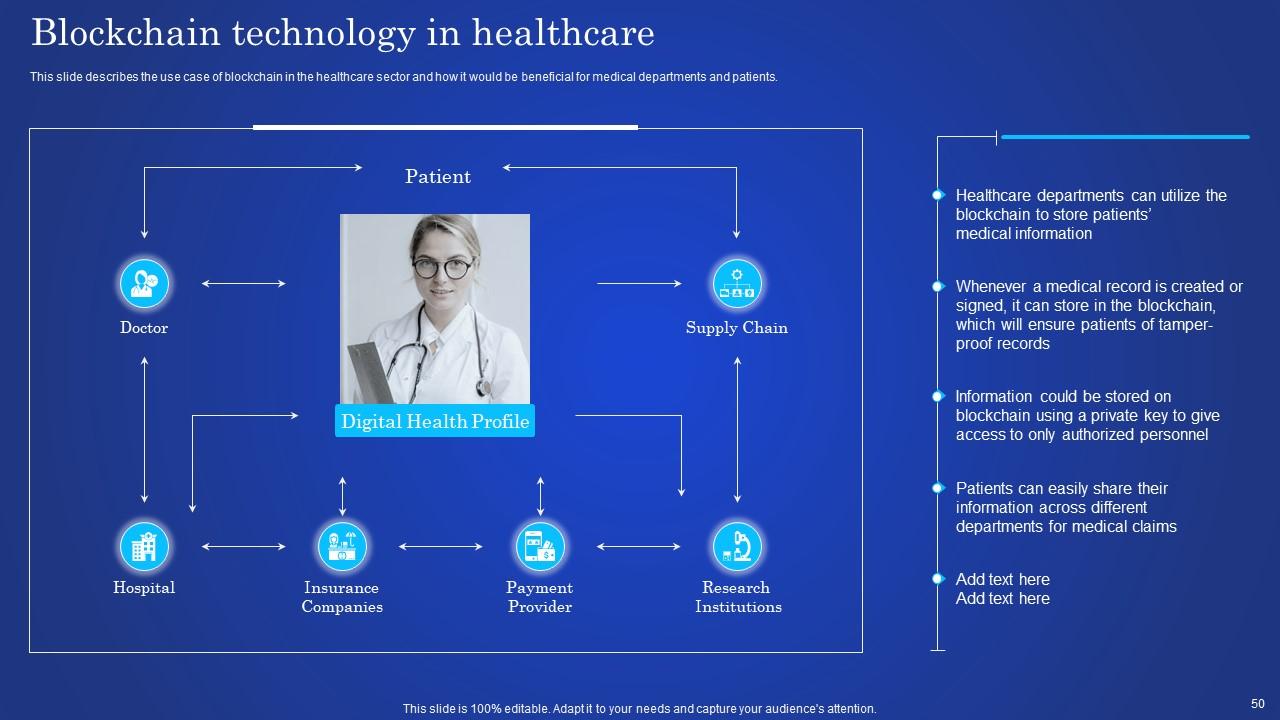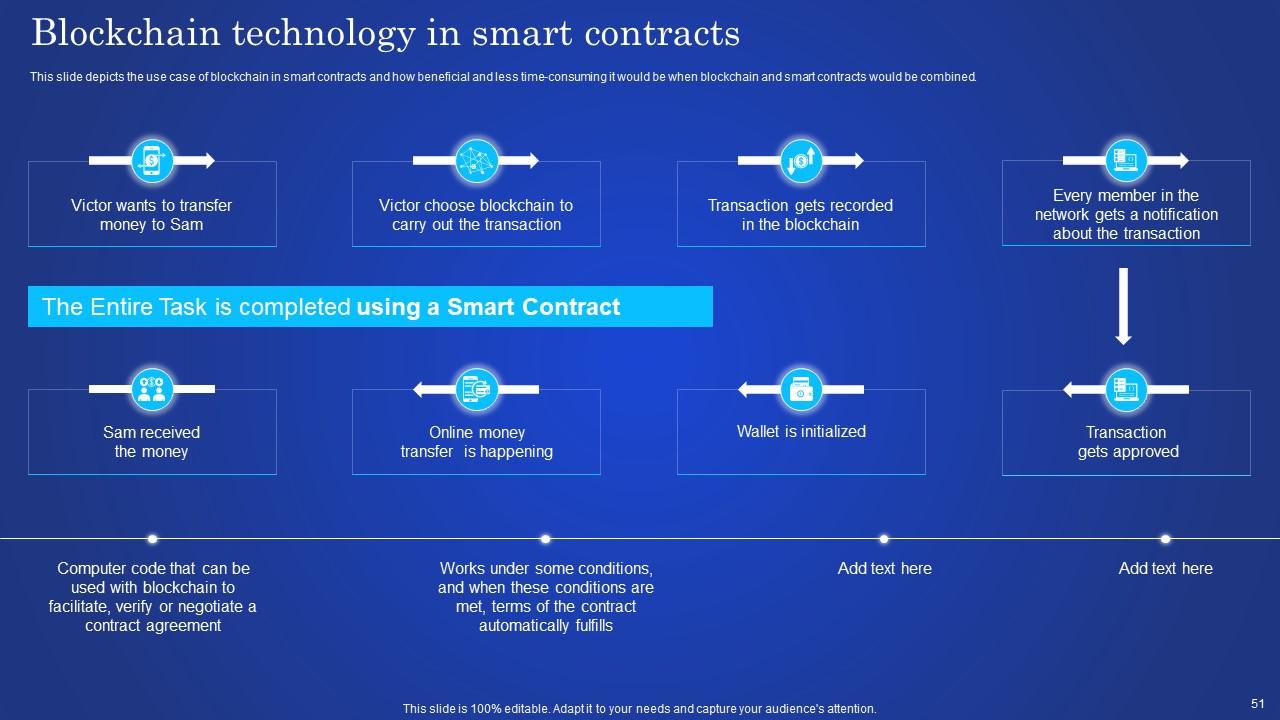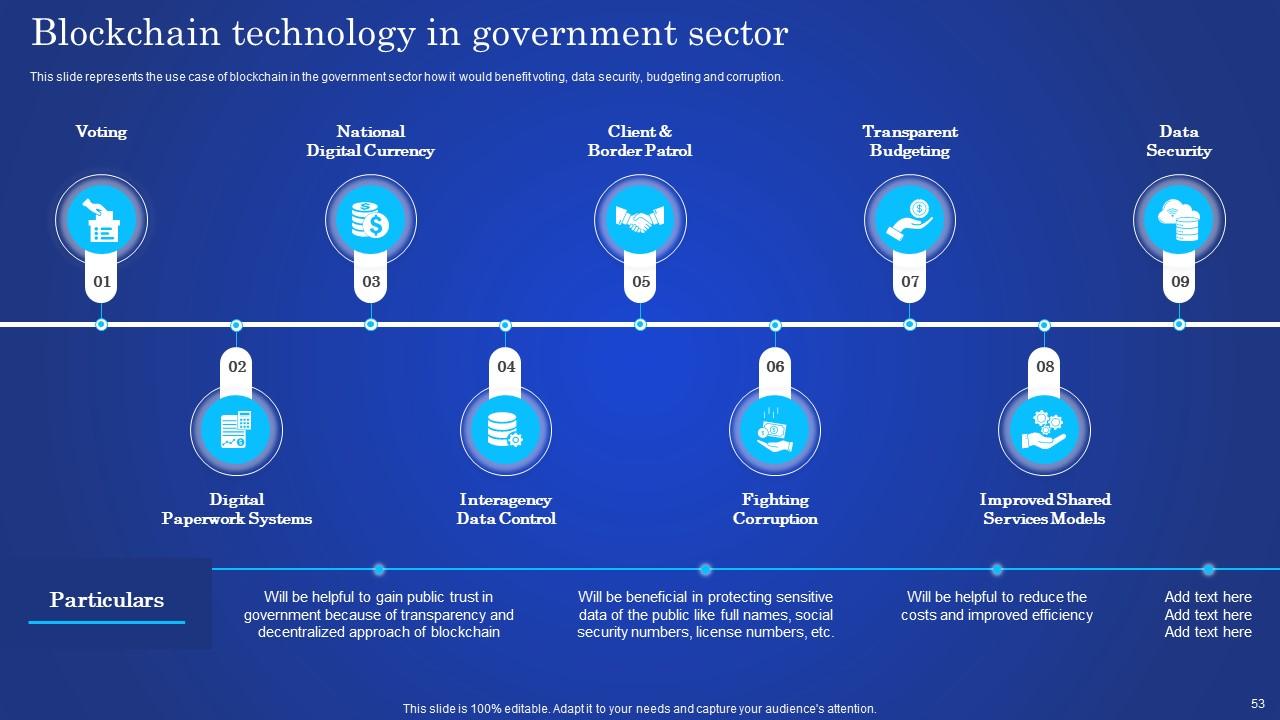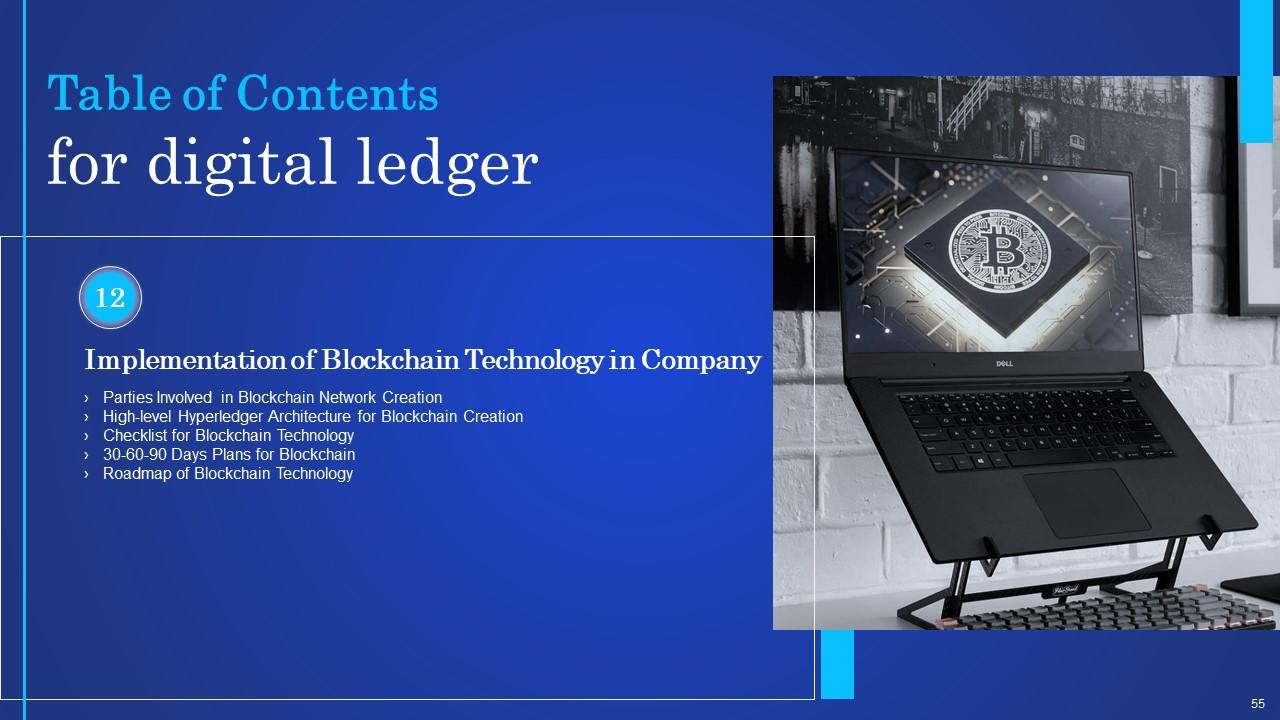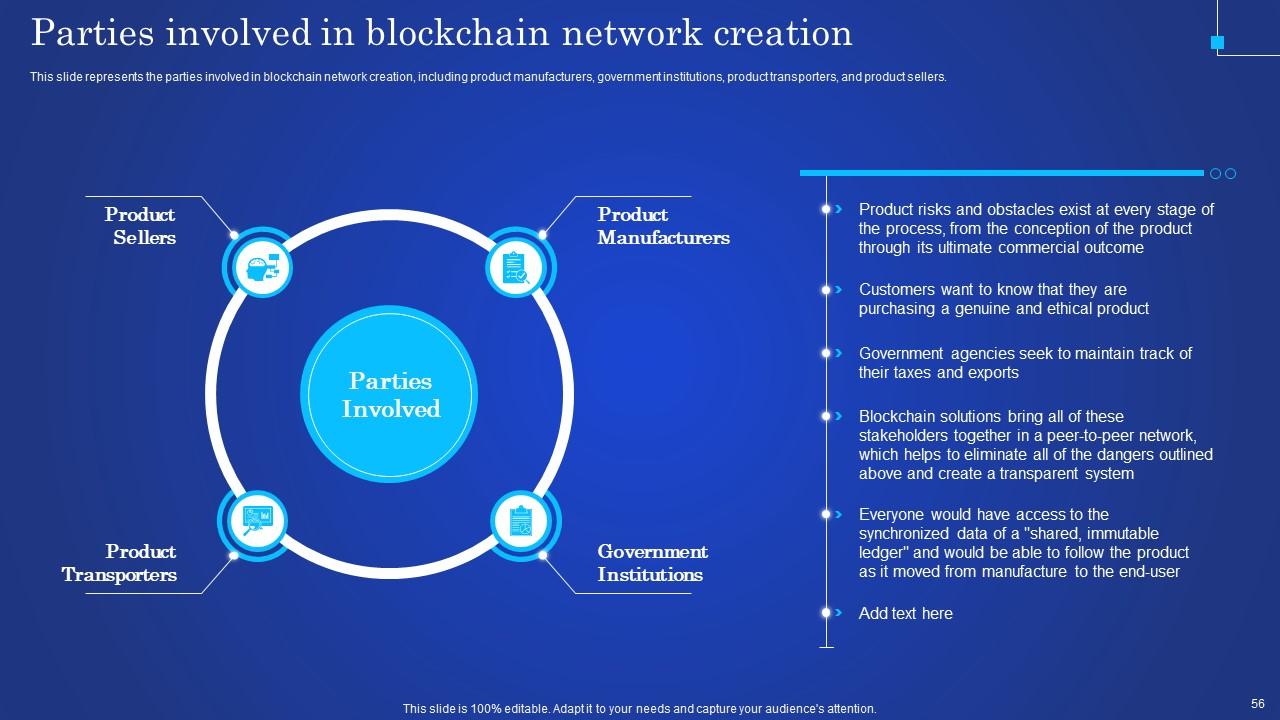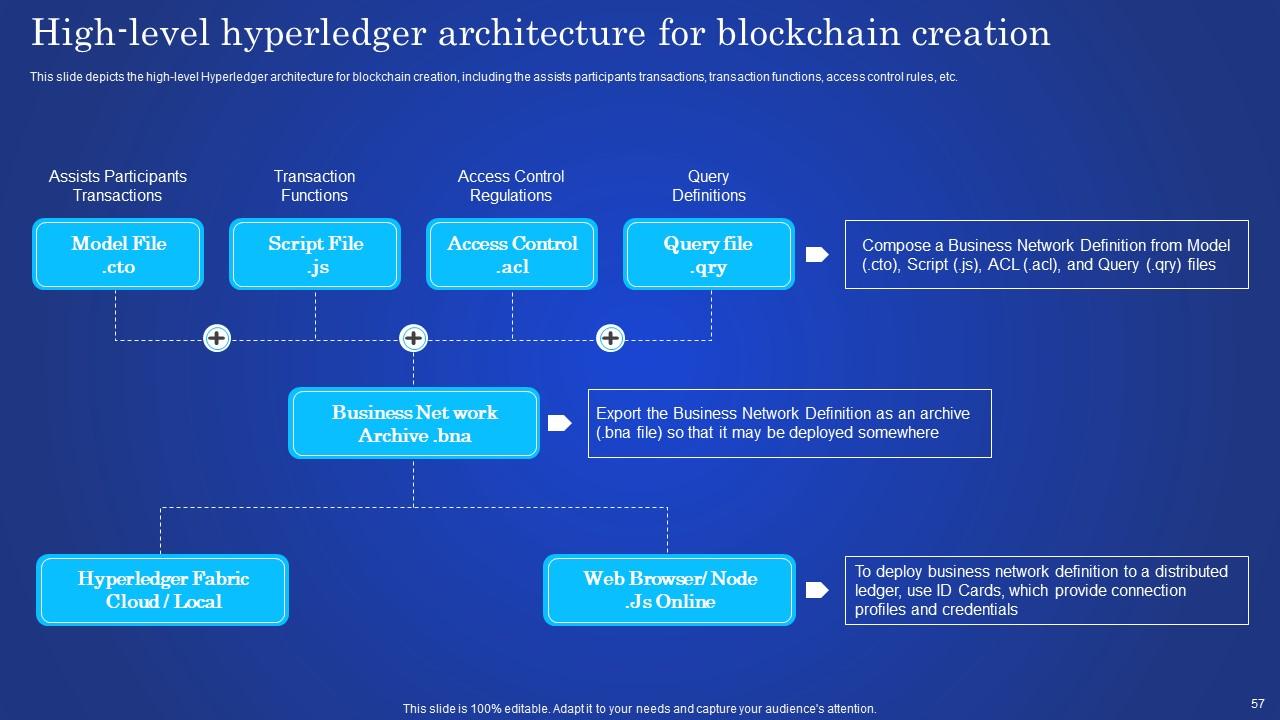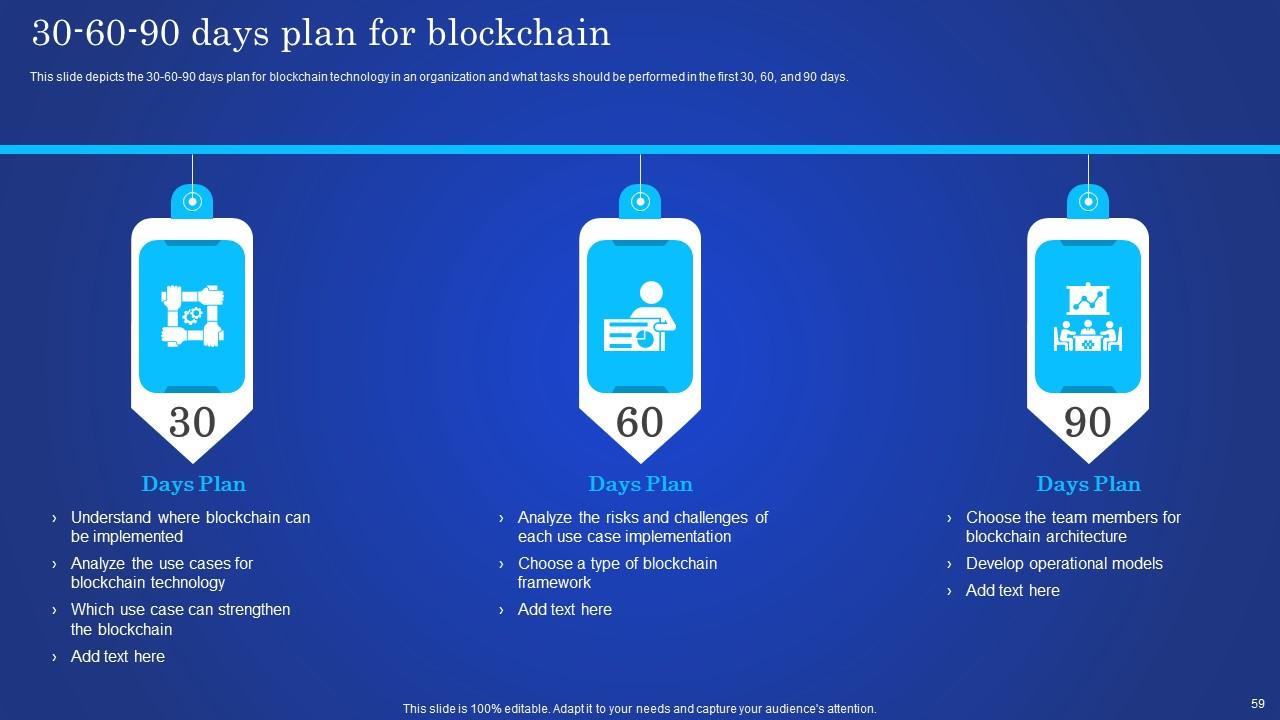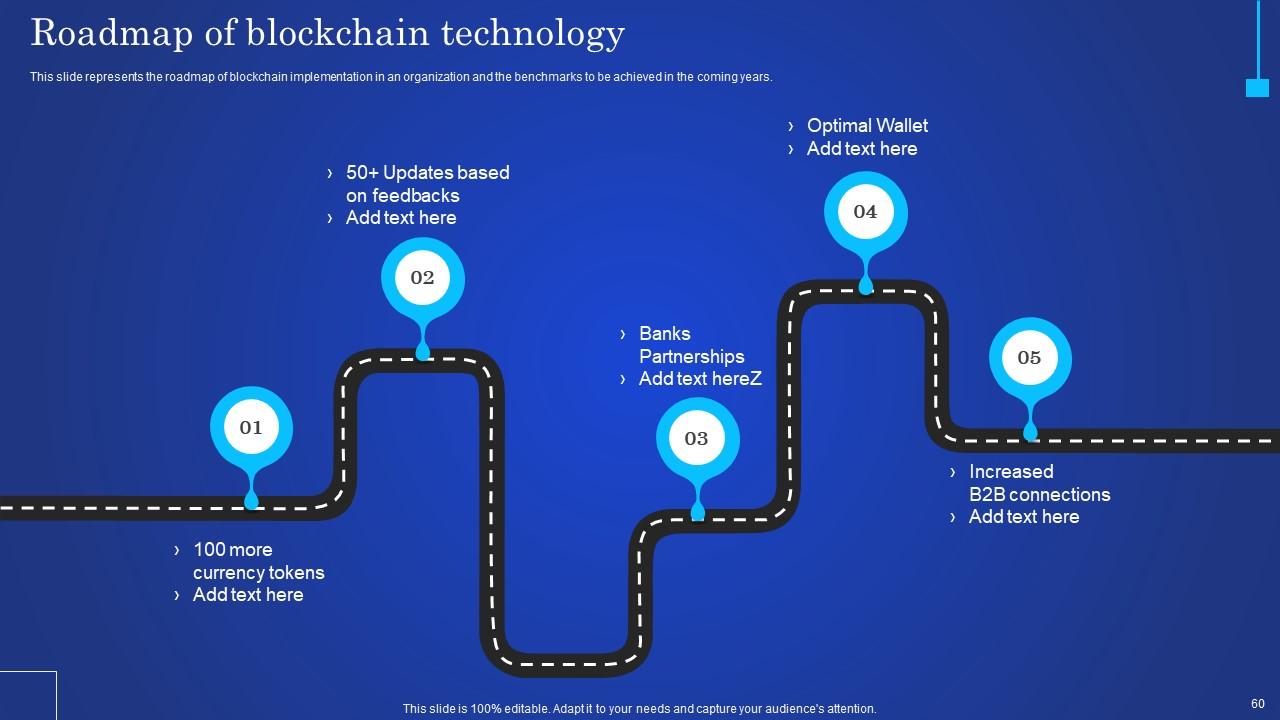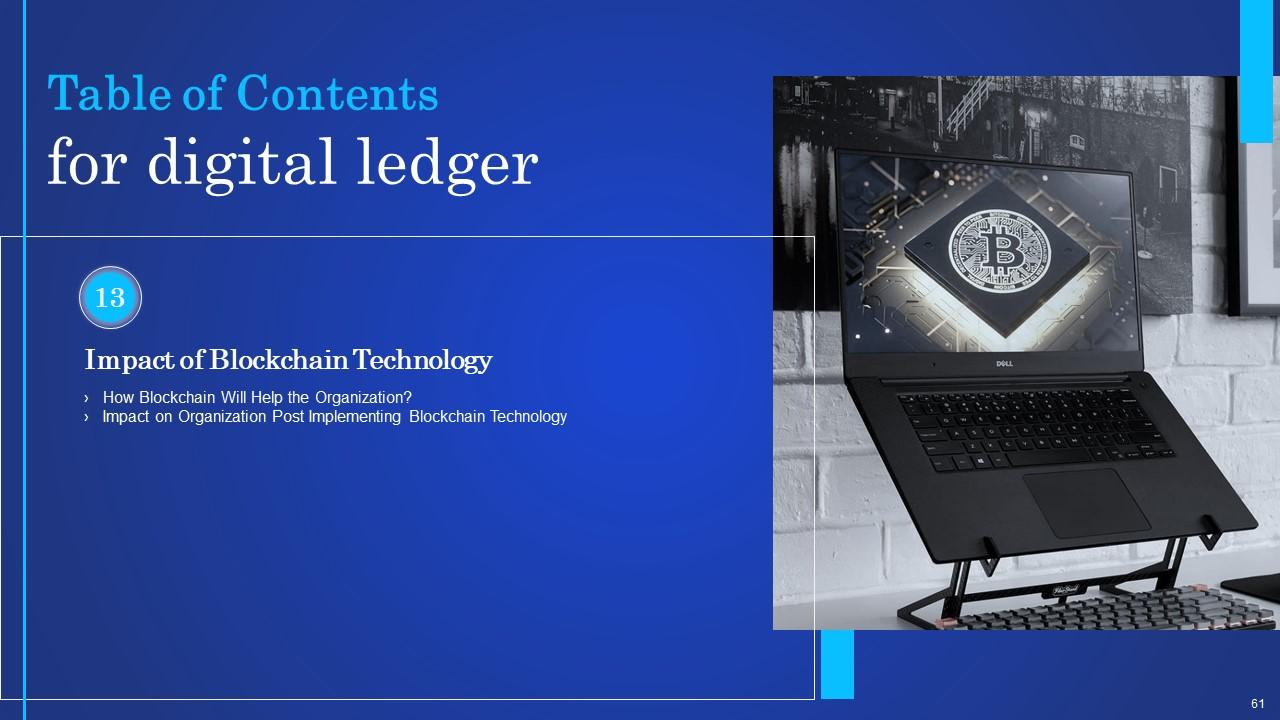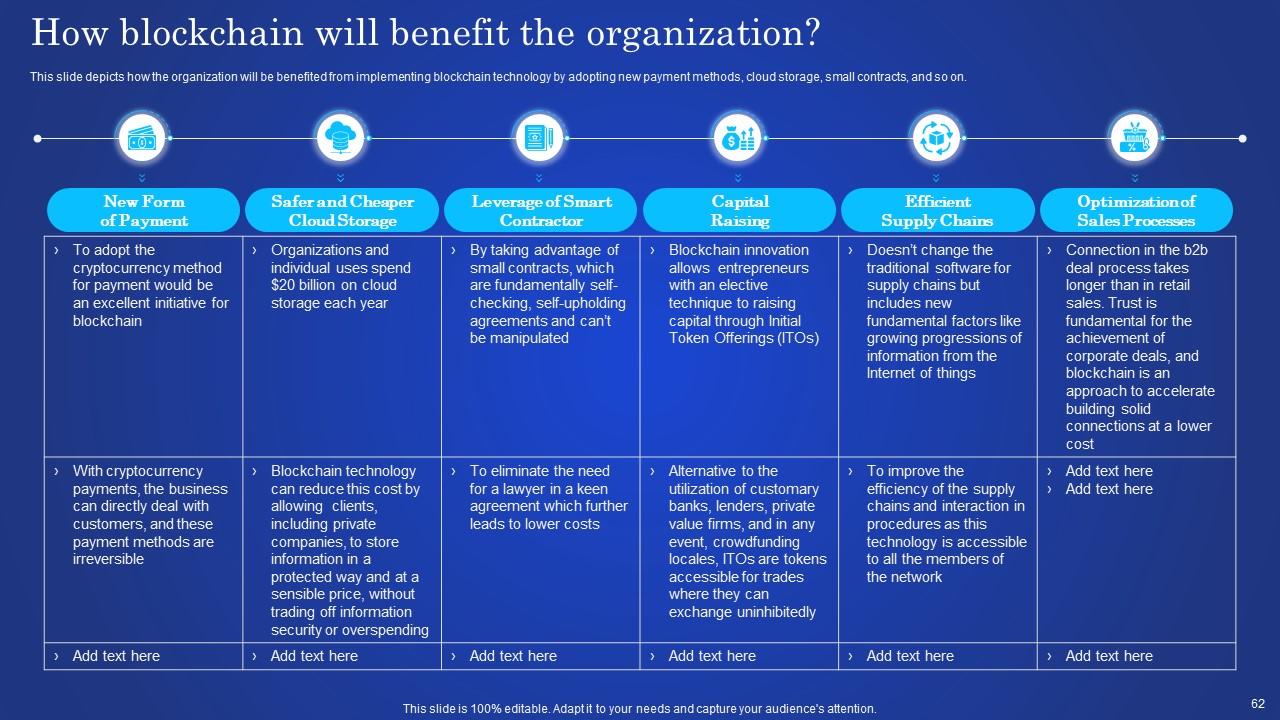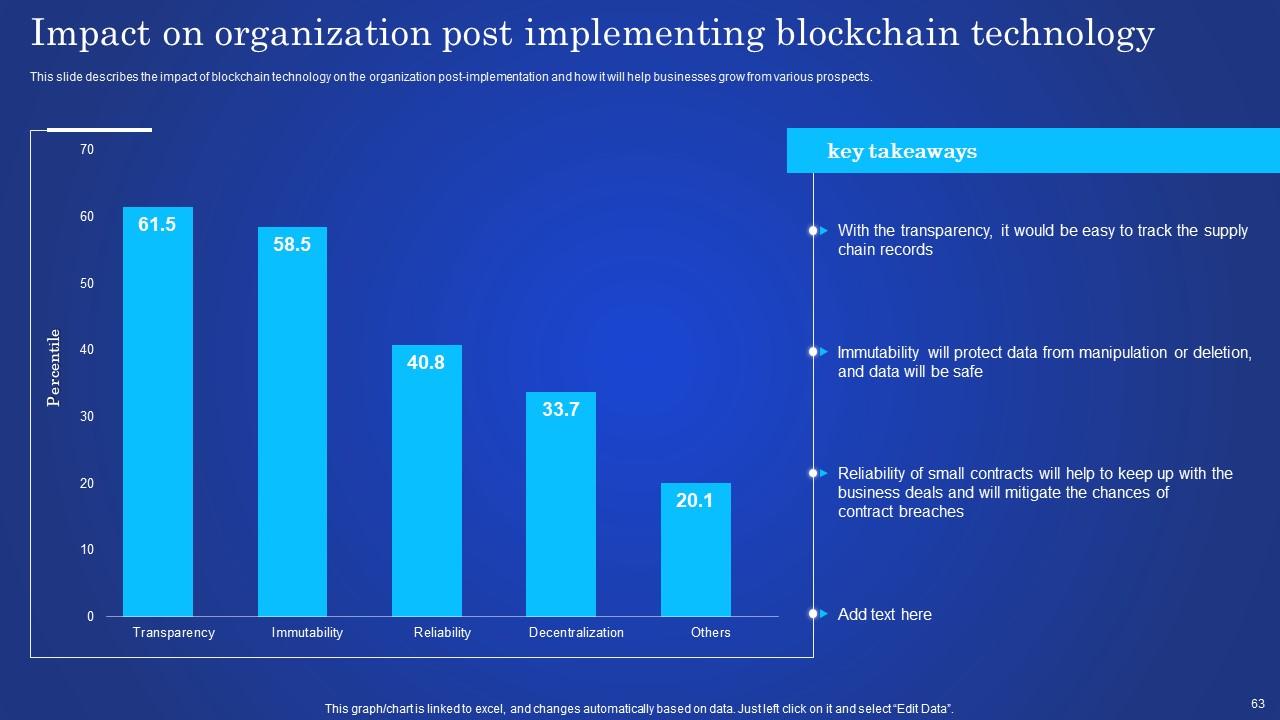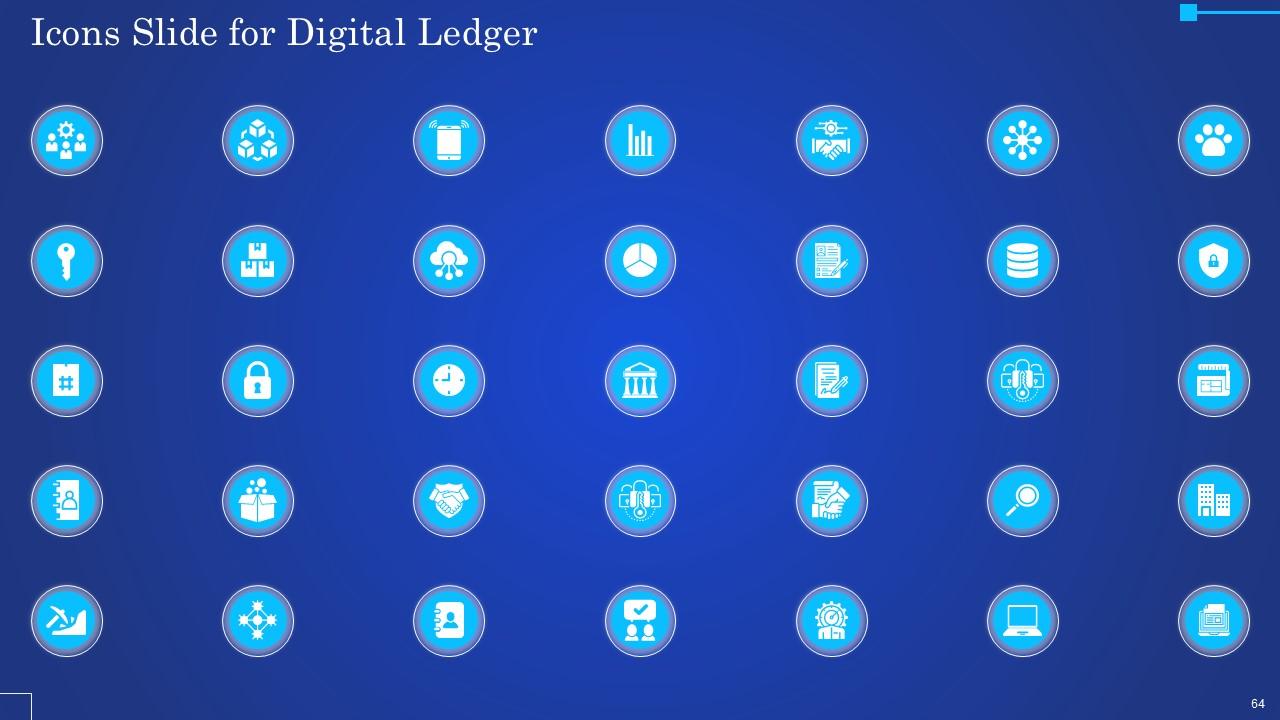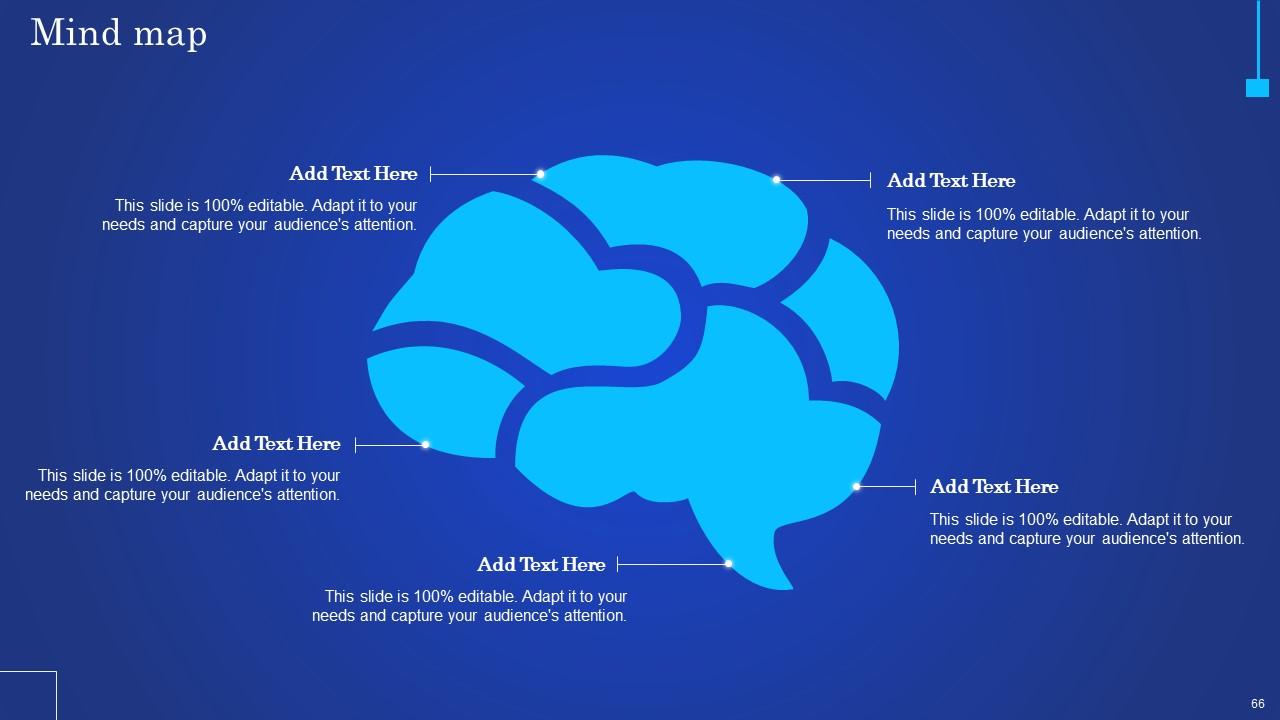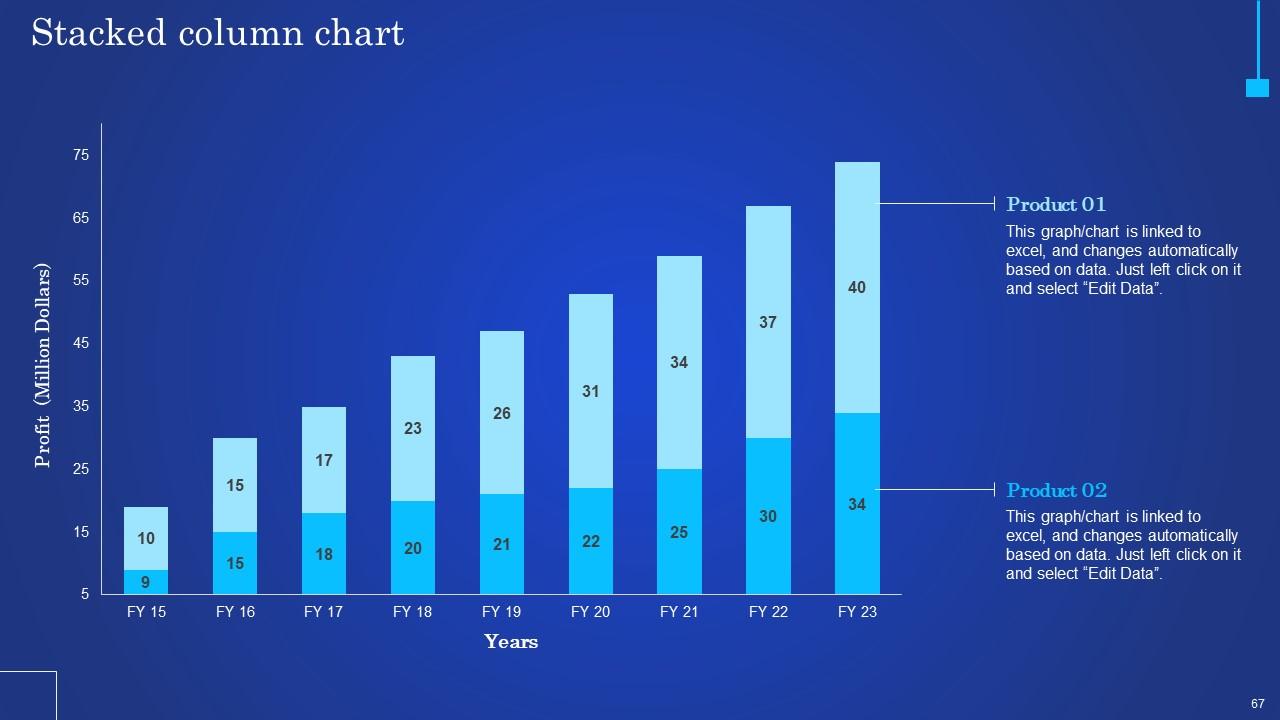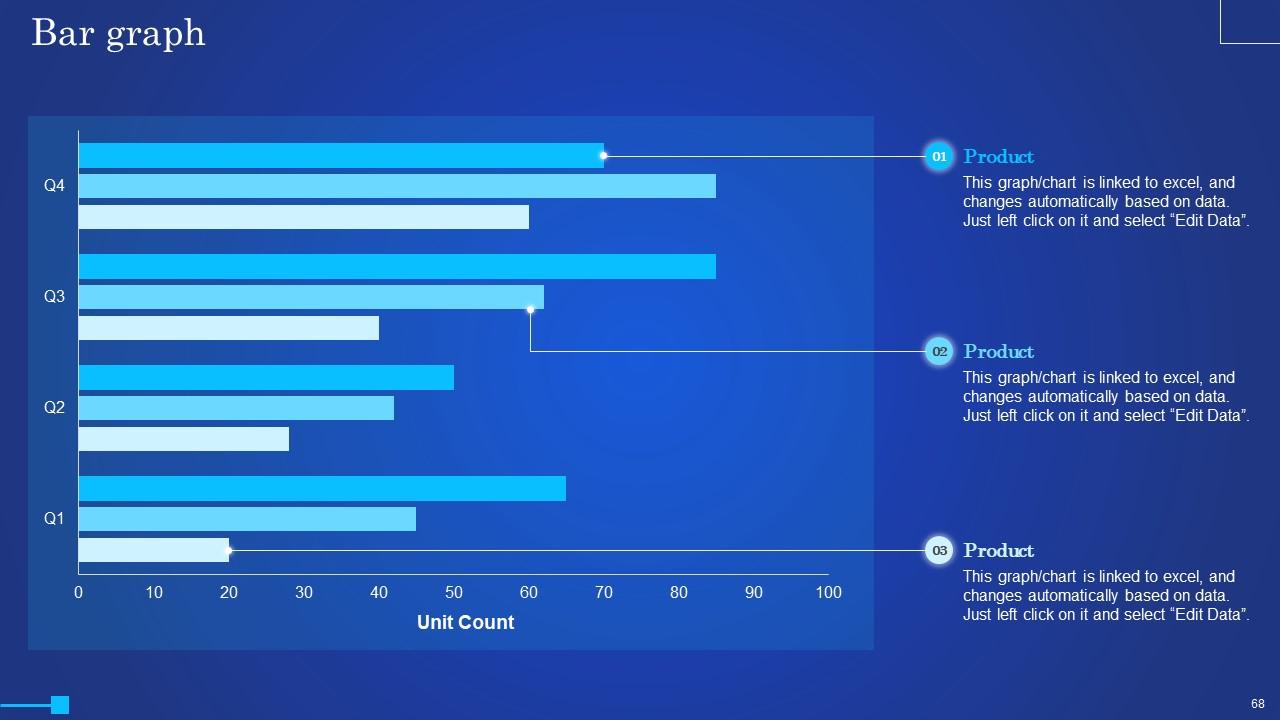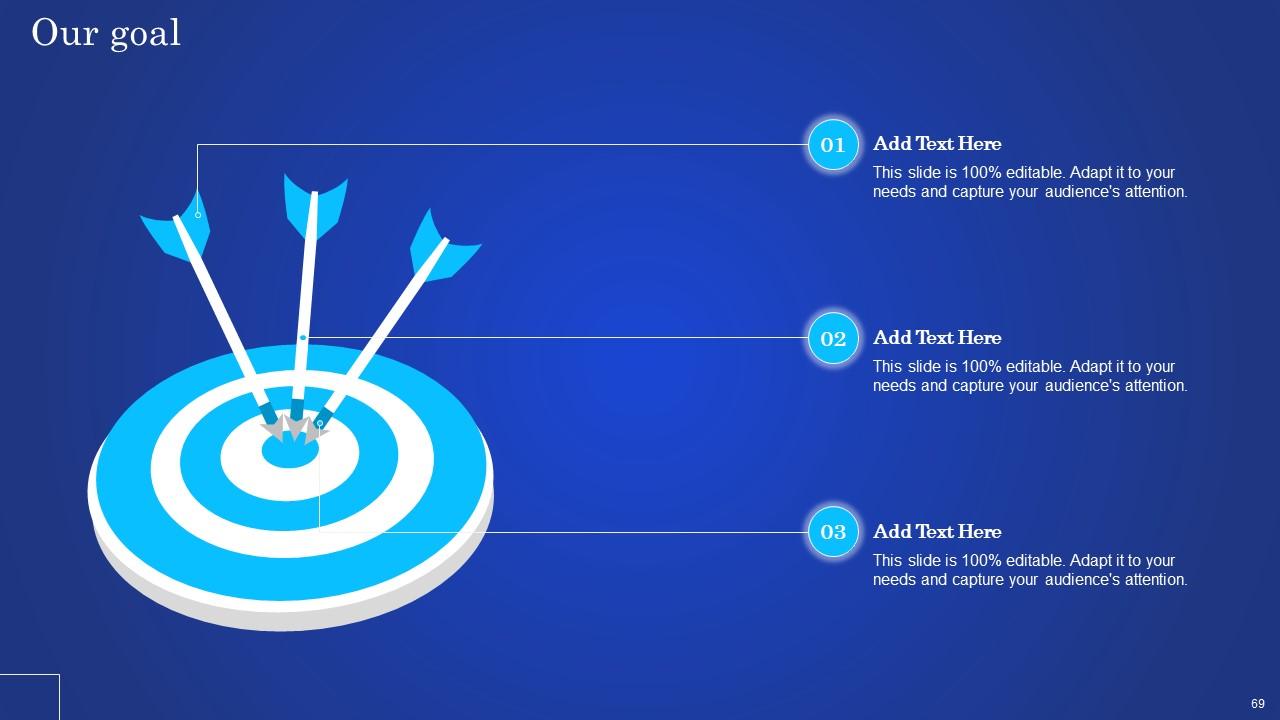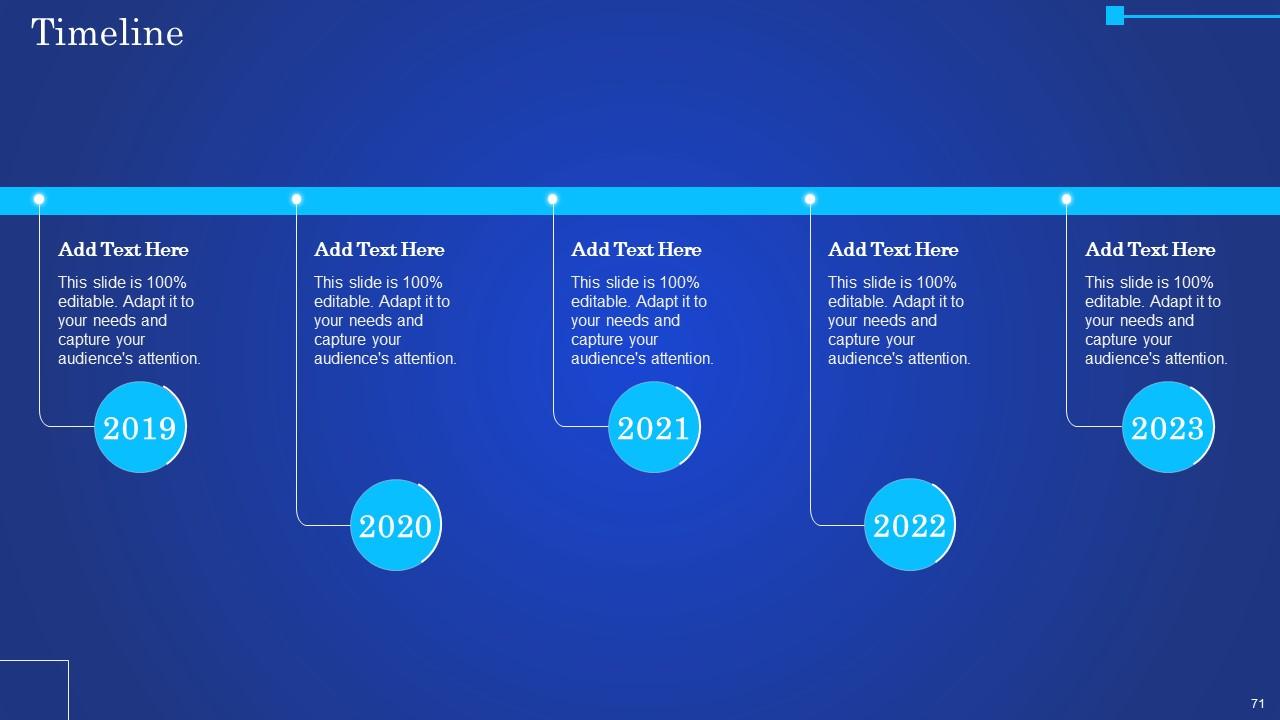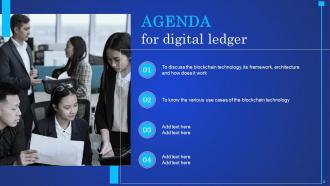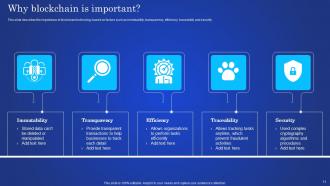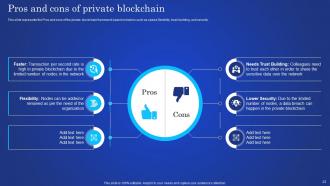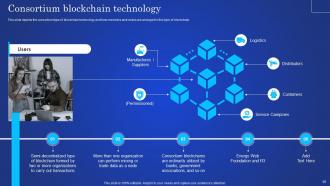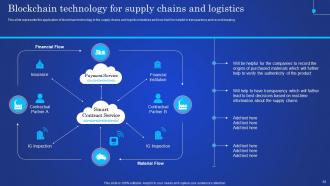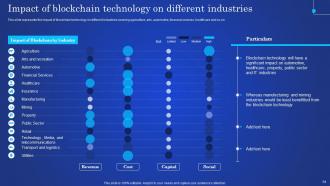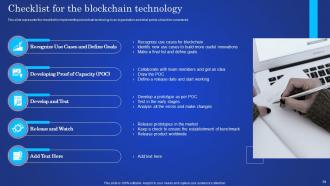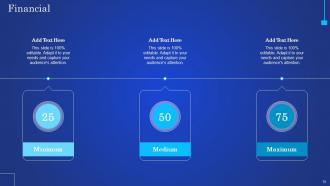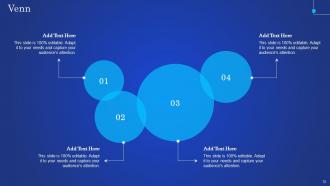Digital Ledger IT Powerpoint Presentation Slides
Want to elucidate the importance of blockchain technology with information about its various features in your company. Here is a competently designed template on Digital Ledger that lets you depict your organizations current situation by describing the problems that occurred in the past years. In addition, distributed ledger template showcases the core components of blockchain architecture and its characteristics. It also throws light on the components of each block in blockchain technology along with its architecture. Moreover, this digital ledger presentation represents how a transaction gets into blockchain and details different blockchain technologies such as private, public, consortium, hybrid, etc. Further, the cryptographic ledger template highlights details on the three pillars of blockchain technology, its pros and cons, bitcoin vs. blockchain technology, blockchain security, and the market of blockchain. Lastly, the blockchain deck showcases the application of blockchain in different sectors, the impact of blockchain technology, a checklist, a 30-60-90-day plan, and a roadmap for blockchain implementation. Our designers have created 100 percent customizable templates, keeping your convenience in mind. Press the download button to bag this fabulous deck today.
Want to elucidate the importance of blockchain technology with information about its various features in your company. Here..
- Google Slides is a new FREE Presentation software from Google.
- All our content is 100% compatible with Google Slides.
- Just download our designs, and upload them to Google Slides and they will work automatically.
- Amaze your audience with SlideTeam and Google Slides.
-
Want Changes to This PPT Slide? Check out our Presentation Design Services
- WideScreen Aspect ratio is becoming a very popular format. When you download this product, the downloaded ZIP will contain this product in both standard and widescreen format.
-

- Some older products that we have may only be in standard format, but they can easily be converted to widescreen.
- To do this, please open the SlideTeam product in Powerpoint, and go to
- Design ( On the top bar) -> Page Setup -> and select "On-screen Show (16:9)” in the drop down for "Slides Sized for".
- The slide or theme will change to widescreen, and all graphics will adjust automatically. You can similarly convert our content to any other desired screen aspect ratio.
Compatible With Google Slides

Get This In WideScreen
You must be logged in to download this presentation.
PowerPoint presentation slides
Deliver an informational PPT on various topics by using this Digital Ledger IT Powerpoint Presentation Slides. This deck focuses and implements best industry practices, thus providing a birds-eye view of the topic. Encompassed with seventy three slides, designed using high-quality visuals and graphics, this deck is a complete package to use and download. All the slides offered in this deck are subjective to innumerable alterations, thus making you a pro at delivering and educating. You can modify the color of the graphics, background, or anything else as per your needs and requirements. It suits every business vertical because of its adaptable layout.
People who downloaded this PowerPoint presentation also viewed the following :
Content of this Powerpoint Presentation
Slide 1: This slide displays the title Digital Ledger (IT).
Slide 2: This slide displays the title AGENDA.
Slide 3: This slide exhibit table of content.
Slide 4: This slide exhibit table of content.
Slide 5: This slide exhibit table of content- Problems Experienced by the Organization.
Slide 6: This slide depicts the problems experienced by the organization.
Slide 7: This slide exhibit table of content- Introduction of Blockchain.
Slide 8: This slide defines the meaning of blockchain technology and its various features.
Slide 9: This slide depicts the vital elements of blockchain technology.
Slide 10: This slide represents the framework of blockchain technology and tasks are performed at each layer.
Slide 11: This slide describes the importance of blockchain technology based on factors such as immutability, transparency, efficiency, traceability and security.
Slide 12: This slide exhibit table of content- About Blockchain Architecture.
Slide 13: This slide defines the architecture of blockchain technology and the parties involved in the blockchains.
Slide 14: This slide represents the core components of the blockchain architecture, such as node, transaction, block, chain, miners, and consensus.
Slide 15: This slide depicts the critical characteristics of blockchain architecture.
Slide 16: This slide represents the architecture of a block in blockchain technology by covering details of its components.
Slide 17: This slide exhibit table of content- Working of Blockchain Technology.
Slide 18: This slide shows the working of blockchain technology and the limit of the information that can be stored in blocks.
Slide 19: This slide depicts how blockchain technology works in the network by covering details of a task assigned, its creation, sharing it with other nodes to its completion.
Slide 20: This slide shows the process of a transaction carried out from a blockchain network.
Slide 21: This slide exhibit table of content- Different Types of Blockchain Technologies.
Slide 22: This slide depicts the private blockchain technology, participants of the private blockchain network, and the method to access data by the members of the network.
Slide 23: This slide represents the Pros and cons of the private blockchain framework based on factors such as speed, flexibility, trust-building, and security.
Slide 24: This slide depicts the public blockchain technology framework and how data is stored in the public blockchain, bitcoin, voting.
Slide 25: This slide represents the pros and cons of public blockchain technology based on factors such as trustworthiness, security, openness and transparency.
Slide 26: This slide depicts the consortium type of blockchain technology and how members and nodes are arranged in this type of blockchain.
Slide 27: This slide describes the pros and cons of consortium blockchain technology and how it is different than other blockchain frameworks.
Slide 28: This slide defines the hybrid type of blockchain technology and how it is established by combining two different types of blockchain, namely private and public.
Slide 29: This slide depicts the pros and cons of the hybrid blockchain technology based on factors such as architecture, scalability and transparency.
Slide 30: This slide depicts the comparison between the different types of blockchain, such as public, private, and hybrid, based on cost, KYC, rewards, etc.
Slide 31: This slide exhibit table of content- Three Pillars of Blockchain Technology.
Slide 32: This slide describes the decentralization process in blockchain technology and the benefits of decentralization.
Slide 33: This slide represents the first pillar of blockchain technology, transparency, and how users' identities remain hidden in this technology.
Slide 34: This slide depicts the immutability pillar of blockchain technology and how blocks are linked to each other with the help of hash code.
Slide 35: This slide exhibit table of content- Pros and Cons of Blockchain Technology.
Slide 36: This slide represents the various advantages of blockchain technology based on information security, digital freedom, privacy, and lower transaction fees.
Slide 37: This slide defines the various disadvantages of blockchain technology based on speed, energy, cost, scalability, maturity, and integration.
Slide 38: This slide exhibit table of content- Blockchain Technology and Other Technologies.
Slide 39: This slide defines the difference between bitcoin and blockchain technology based on goal, trade, scope, strategy and status.
Slide 40: This slide depicts the various factors that make blockchain different from the database system.
Slide 41: This slide represents the comparison between blockchain technology and the bank system.
Slide 42: This slide exhibit table of content- Blockchain Security.
Slide 43: This slide defines the security of blockchain technology and how hash codes are helpful to maintain data integrity and security in blockchain.
Slide 44: This slide defines the various risks involved in public blockchains, such as 51% attacks, double spending, and proof of work.
Slide 45: This slide represents the challenges involved in public blockchains classified as basic risks, implementation risks, security risks, and legal risks.
Slide 46: This slide exhibit table of content- Market Size of Blockchain Technology.
Slide 47: This slide describes the market share of blockchain technology and the compound annual growth rate (CAGR) from 2020 to 2025.
Slide 48: This slide exhibit table of content- How Blockchain Works for Different Sectors.
Slide 49: This slide depicts the use cases of blockchain technology in the banking and finance sector, including payment systems, share market, and trade finance.
Slide 50: This slide describes the use case of blockchain in the healthcare sector and how it would be beneficial for medical departments and patients.
Slide 51: This slide depicts the use case of blockchain in smart contracts and how beneficial and less time-consuming it would be.
Slide 52: This slide represents the application of blockchain technology in the supply chains and logistic industries.
Slide 53: This slide represents the use case of blockchain in the government sector how it would benefit voting, data security, budgeting and corruption.
Slide 54: This slide represents the impact of blockchain technology on different industries covering agriculture, arts, automotive, financial services, healthcare and so on.
Slide 55: This slide exhibit table of content- Implementation of Blockchain Technology in Company.
Slide 56: This slide represents the parties involved in blockchain network creation.
Slide 57: This slide depicts the high-level Hyperledger architecture for blockchain creation.
Slide 58: This slide represents the checklist for implementing blockchain technology in an organization and what points should be considered.
Slide 59: This slide depicts the 30-60-90 days plan for blockchain technology in an organization and what tasks should be performed in the first 30, 60, and 90 days.
Slide 60: This slide represents the roadmap of blockchain implementation in an organization and the benchmarks to be achieved in the coming years.
Slide 61: This slide exhibit table of content- Impact of Blockchain Technology.
Slide 62: This slide depicts how the organization will be benefited from implementing blockchain technology.
Slide 63: This slide describes the impact of blockchain technology on the organization post-implementation and how it will help businesses grow from various prospects.
Slide 64: This is the icons slide.
Slide 65: This slide presents title for additional slides.
Slide 66: This slide shows Mind map.
Slide 67: This slide exhibits yearly profits stacked line charts for different products.
Slide 68: This slide displays yearly bar graph for different products.
Slide 69: This slide displays Our goal.
Slide 70: This slide displays Financial.
Slide 71: This slide exhibits yearly timeline of company.
Slide 72: This slide displays Venn.
Slide 73: This is thank you slide & contains contact details of company like office address, phone no., etc.
Digital Ledger IT Powerpoint Presentation Slides with all 78 slides:
Use our Digital Ledger IT Powerpoint Presentation Slides to effectively help you save your valuable time. They are readymade to fit into any presentation structure.
FAQs
The core components of blockchain architecture are node, transaction, block, chain, miners, and consensus.
There are four types of blockchain technologies - public, private, consortium, and hybrid.
The three pillars of blockchain technology are decentralization, transparency, and immutability.
The pros of blockchain technology include information security, digital freedom, privacy, and lower transaction fees. The cons of blockchain technology include speed, energy, cost, scalability, maturity, and integration.
Blockchain technology can be used in sectors such as banking and finance, healthcare, smart contracts, supply chain and logistics, government, and various industries like agriculture, arts, automotive, financial services, and healthcare.
-
You know what? I'm so glad I opted for this PPT design. It has been a total game-changer for me and my presentations. Thank you!
-
Easy to use and customize templates. Helped me give a last minute presentation.


